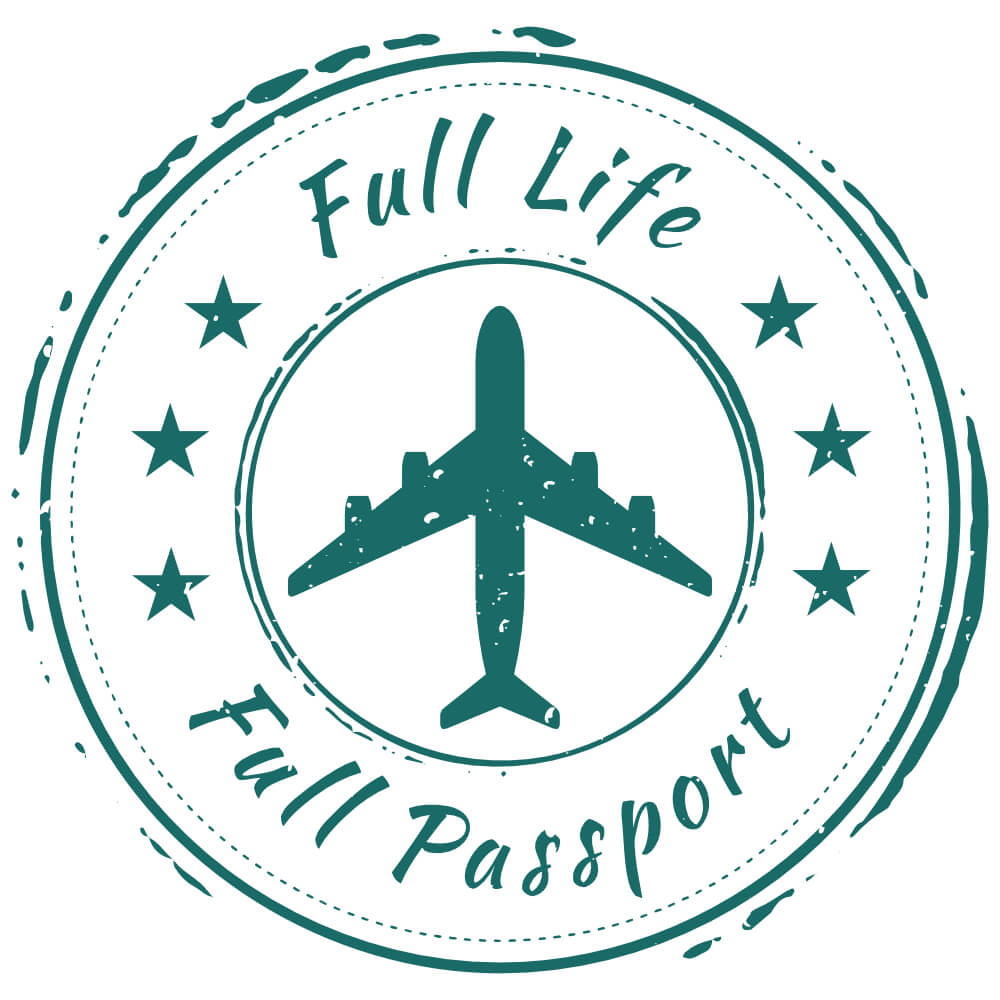M and I were by no means unusual in our priorities for our trip to Italy: we wanted to experience beautiful scenery, a culture steeped in history and tradition, and – perhaps most of all – amazing food. We were fortunate to check all of those off our list over the course of our vacation (it’s not hard to do in Italy!), but the amazing food bit was accomplished right away. At 8:00 AM on our first morning in Italy, we embarked on a full-day food tour around the city of Parma.
Parma is located in the Emilia-Romagna region of northern Italy, about an hour and a half southeast of Milan. This area is known as the “Food Valley” of Italy, which is saying something in a country that is known from top to bottom for its incredible cuisine. Gastronomic traditions run deep in Emilia-Romagna, and there are multiple food products that are cultivated and crafted here and nowhere else. Much like how you can’t call sparkling wine “Champagne” unless it comes from that particular region in France, foodstuffs like proscuitto (or Parma ham), Parmigiano-Reggiano cheese, and balsamic vinegar are endowed with protected status and special designations here.
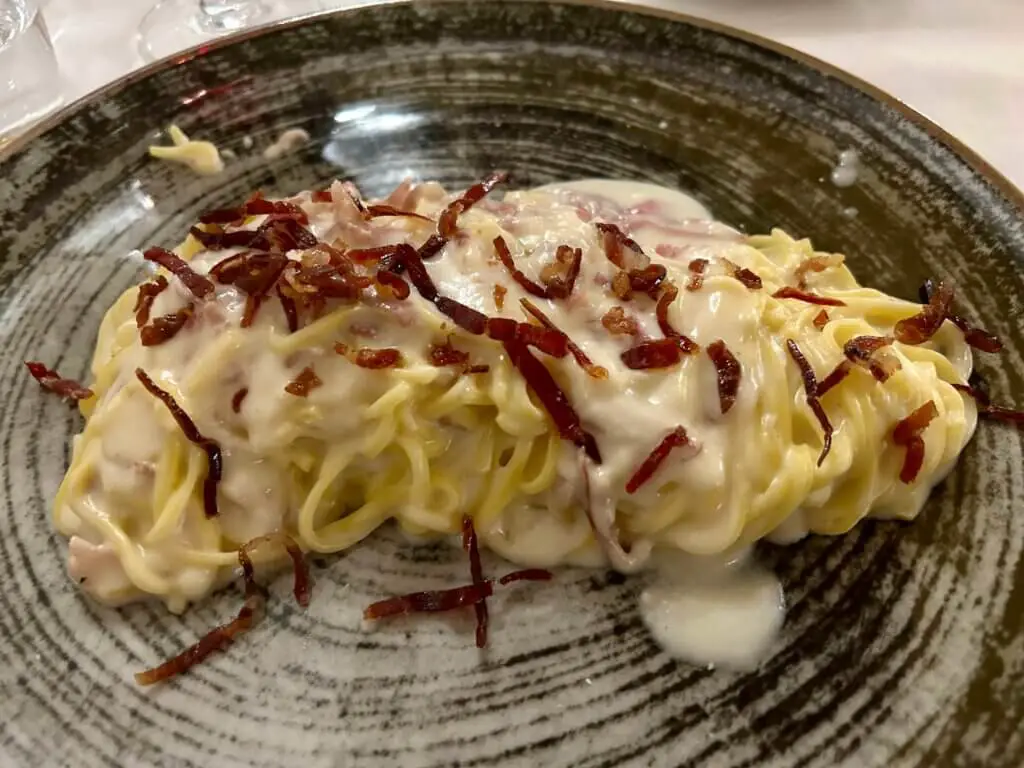
There are two major systems/designations for recognizing and protecting foods produced traditionally in Italy: Denominazione di origine protetta (DOP, or Protected Designation of Origin/PDO) for foods and Denominazione di origine controllata (DOC, or Controlled Designation of Origin/CDO) for wines. These designations indicate that each particular product is made completely in the area in which it originated, exclusively using materials and ingredients from that area, and according to original historical processes and traditions. Each step of each production process is heavily regulated to ensure authenticity and quality.
For our food tour, we chose the “Big Fives” full-day experience from Food Valley Travel. It was a bit of a splurge, as the tour was private and included five different stops and tastings, but we walked away feeling like we had gotten the best and most comprehensive glimpse into Emilia-Romagnan food culture possible. This was due in no small part to our guide, Monica, whose breadth and depth of knowledge about each of the places we visited was only matched by her good humor and ease of conversation. If you’re considering a food tour in Parma or elsewhere in the region, I highly recommend this one!
Stop 1: Parmigiano-Reggiano Cheese
The first stop on our Parma food tour was the Consorzio Produttori Latte, where we were able to witness the production of Parmigiano-Reggiano cheese from start to finish. The Consorzio (consortium, or cooperative) is located just off the highway outside Parma and is a medium-size but high quality producer in the Parmigiano-Reggiano production area
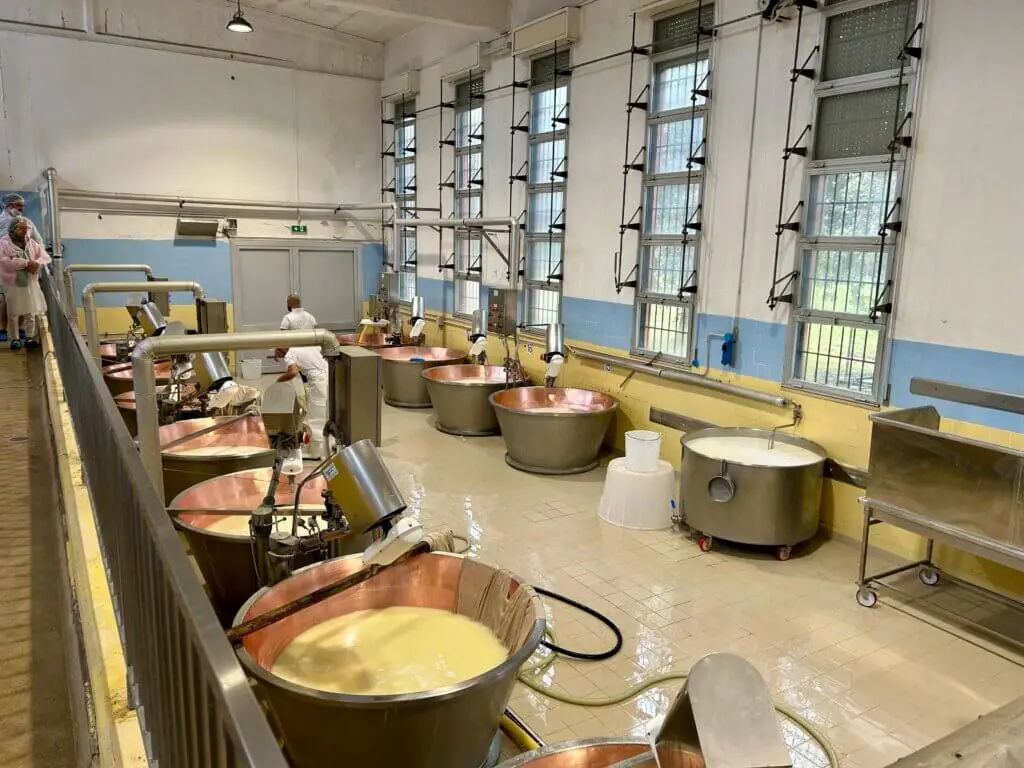
We donned hair and shoe coverings as well as disposable sanitary gowns before entering a room lined with huge copper vats. These steam-heated cauldrons hold about 290 gallons and are where the milk is heated with whey and rennet (a natural enzyme) to form the curd.
We even got to watch as workers pulled the baby Parmigiano-Reggiano from the bottom of the vats and separated it into what would become two wheels of cheese.
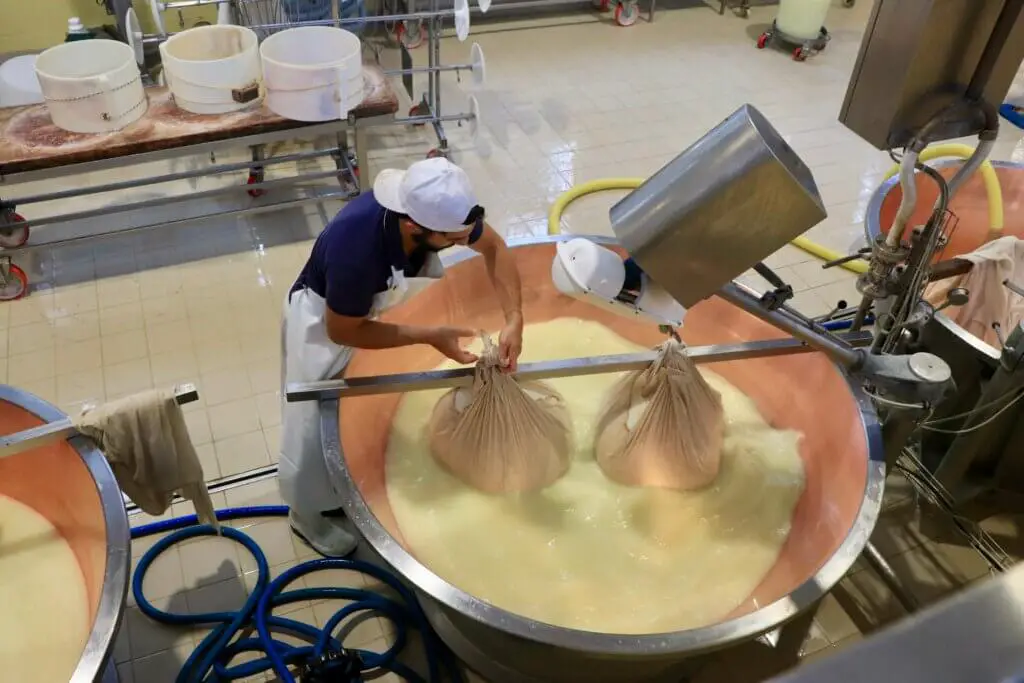
Monica then led us into the drying room…
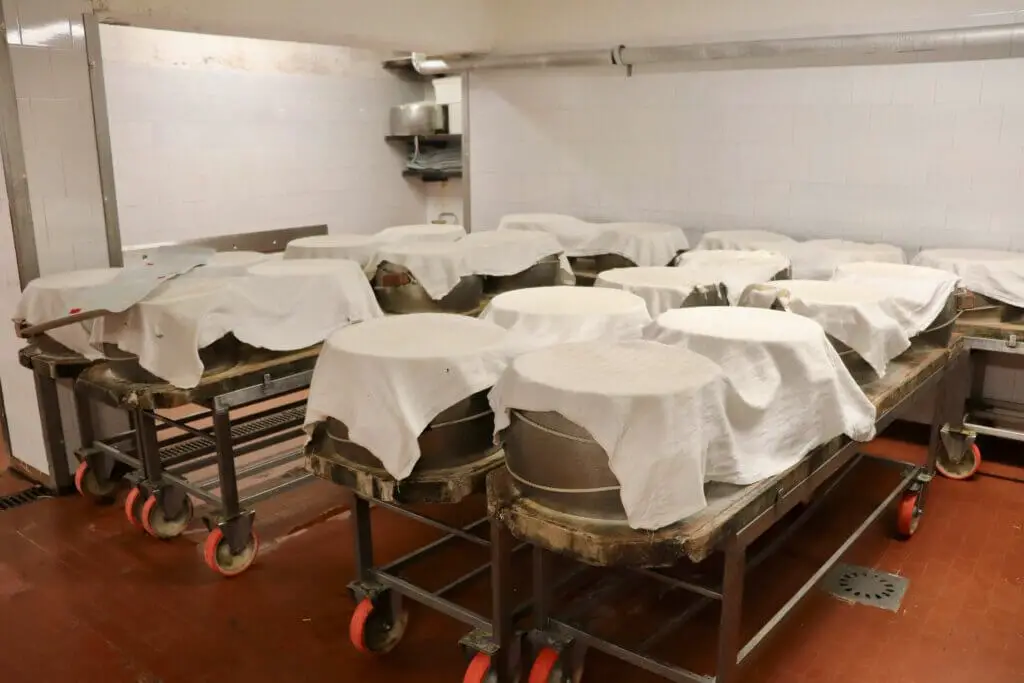
… and another area where the wheels are given a salty bath to enrich their flavor and help preserve the cheese.
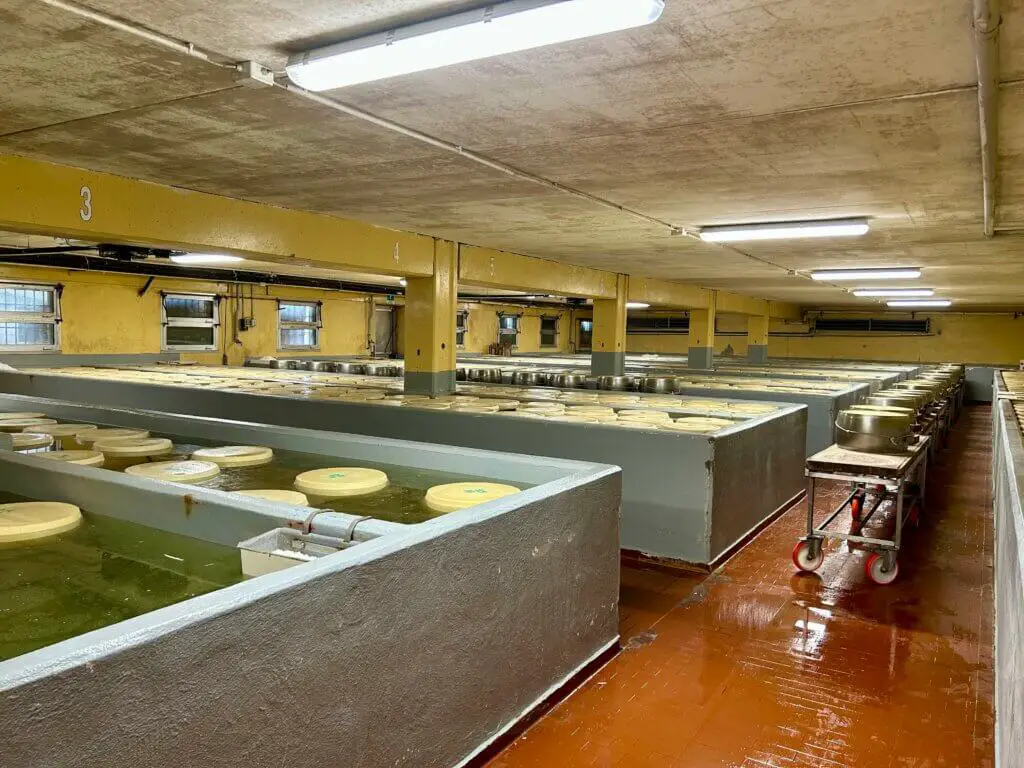
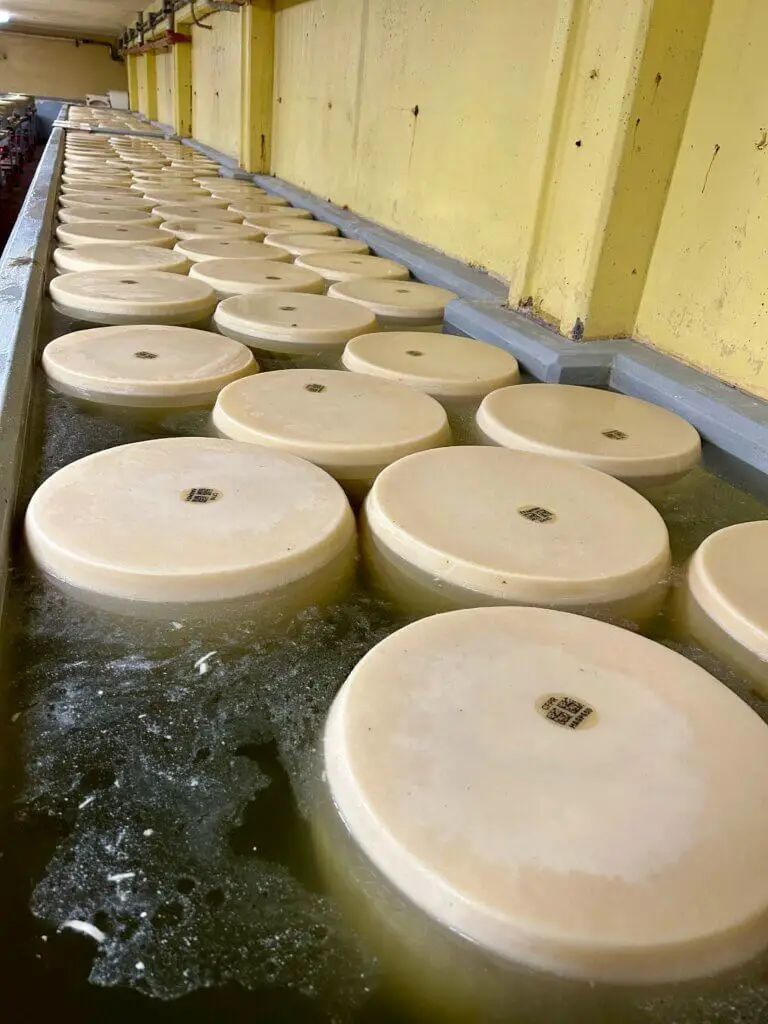
Most magnificent was the aging room, where the fully-processed wheels of cheese spend the next twelve to forty-eight months (or longer!) reaching cheesy perfection. Being in a room filled floor-to-ceiling with cheese is basically my dream come true.
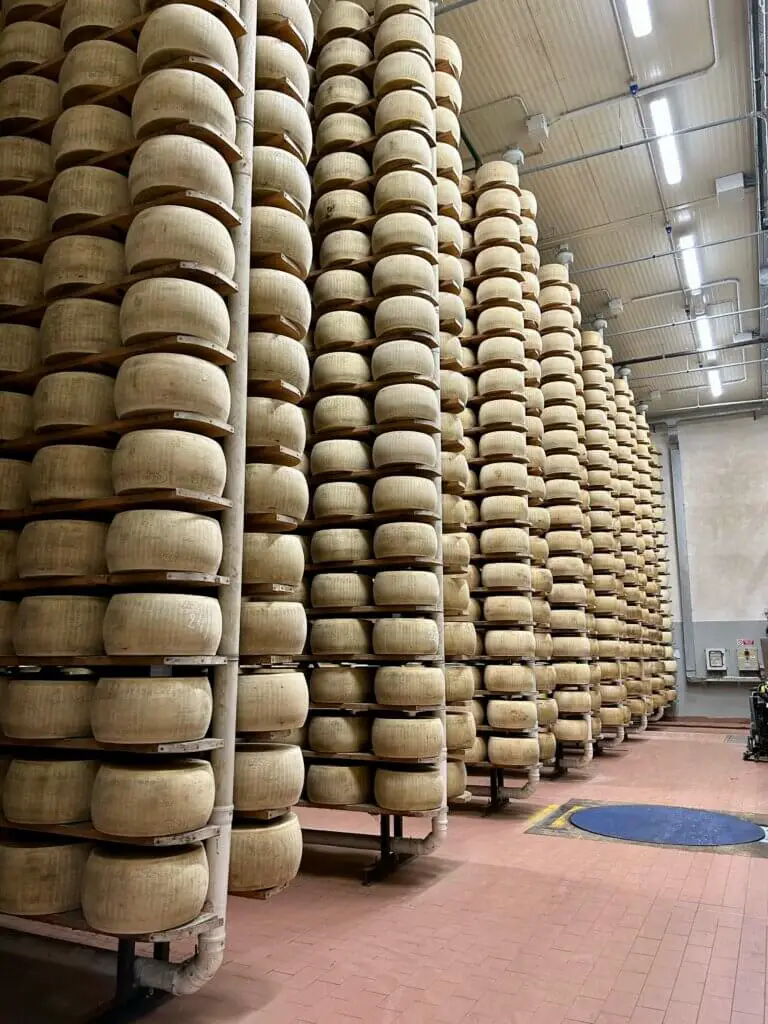
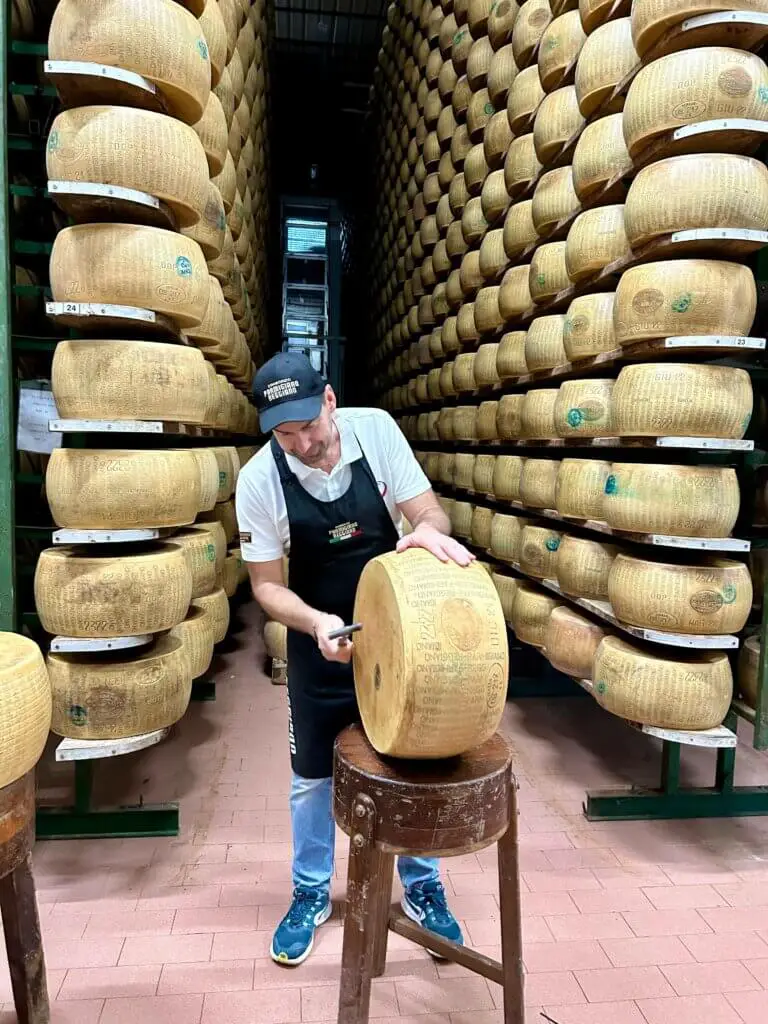
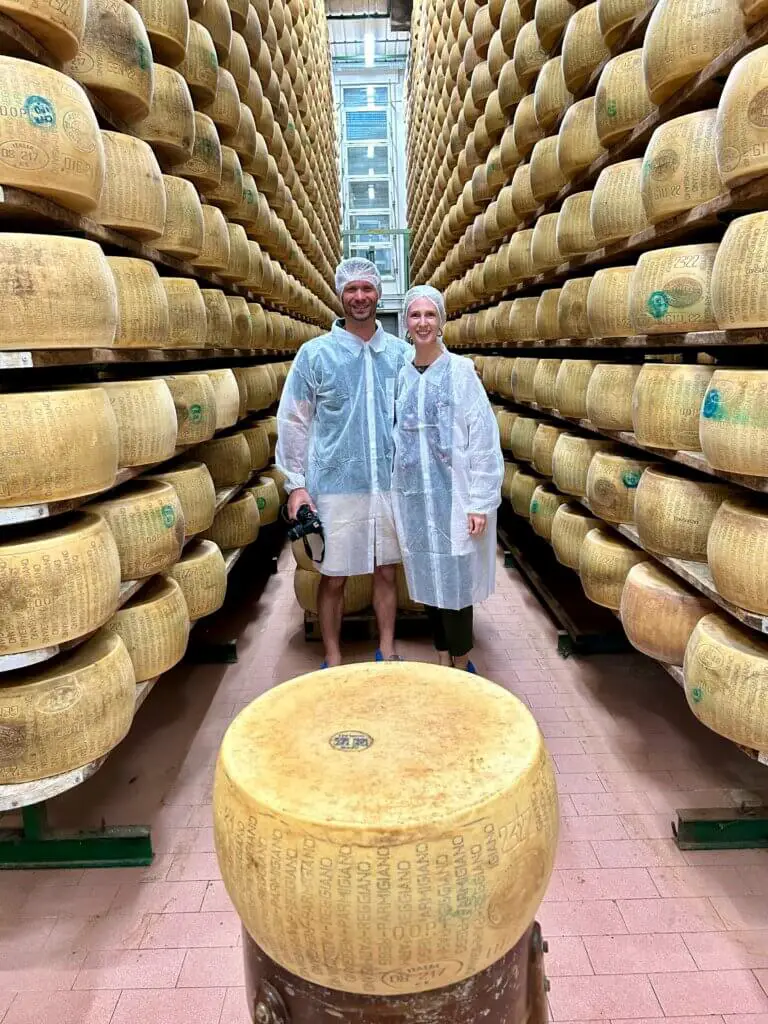
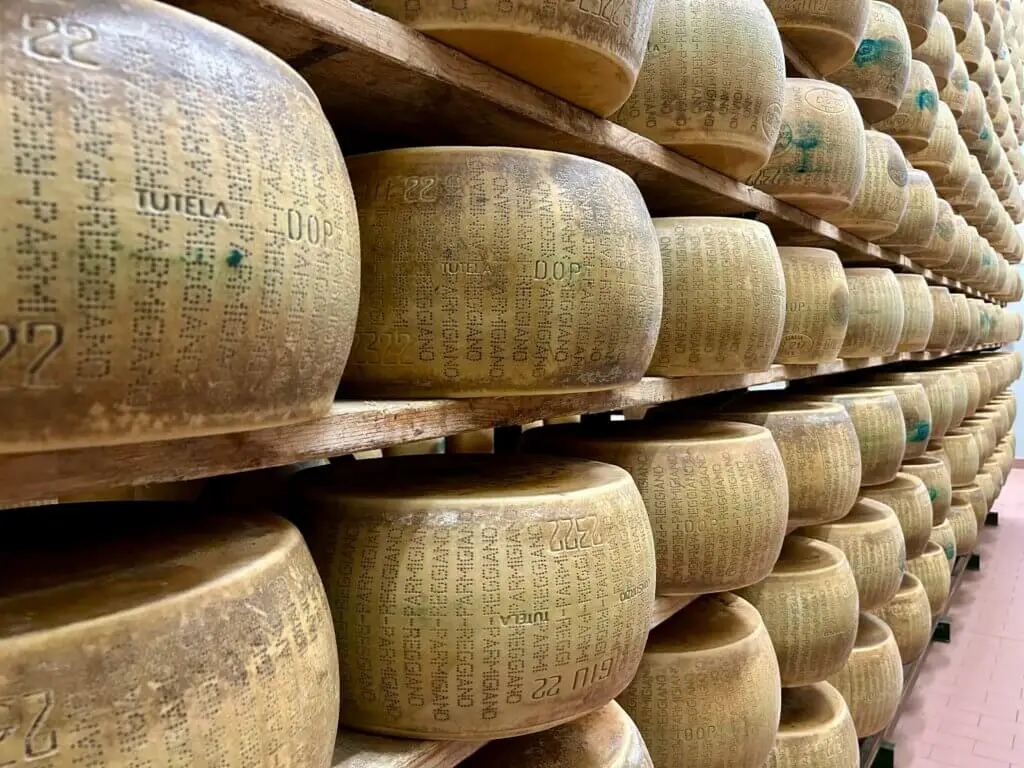
At the end of the tour, we were treated to a tasting of three agings of Parmigiano-Reggiano: twelve, twenty-four, and thirty-six months. I love tastings like this, ones that allow you to sample the same product prepared in different ways, because you really get to appreciate the effect that different variables have on the final product. It’s amazing how cheeses that were created in the exact same way can be so different in structure and flavor profile simply because they were aged for different lengths of time.
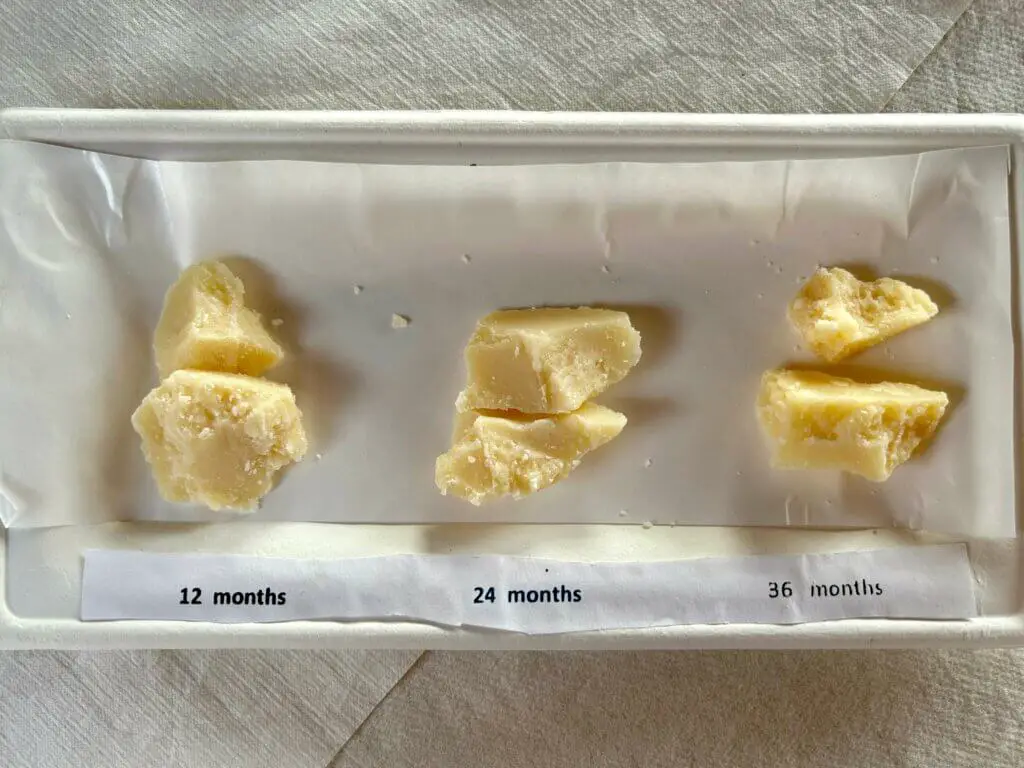
All were delicious, of course. I could have nibbled Parmigiano-Reggiano all the live-long day if we didn’t have so many other tasty stops ahead of us. And speaking of which…
Stop 2: Culatello
The main reason that we chose the Big Fives food tour instead of any of the dozens of other offerings in Parma was because it included our second stop: Antica Corte Pallavicina and its world-renowned culatello.
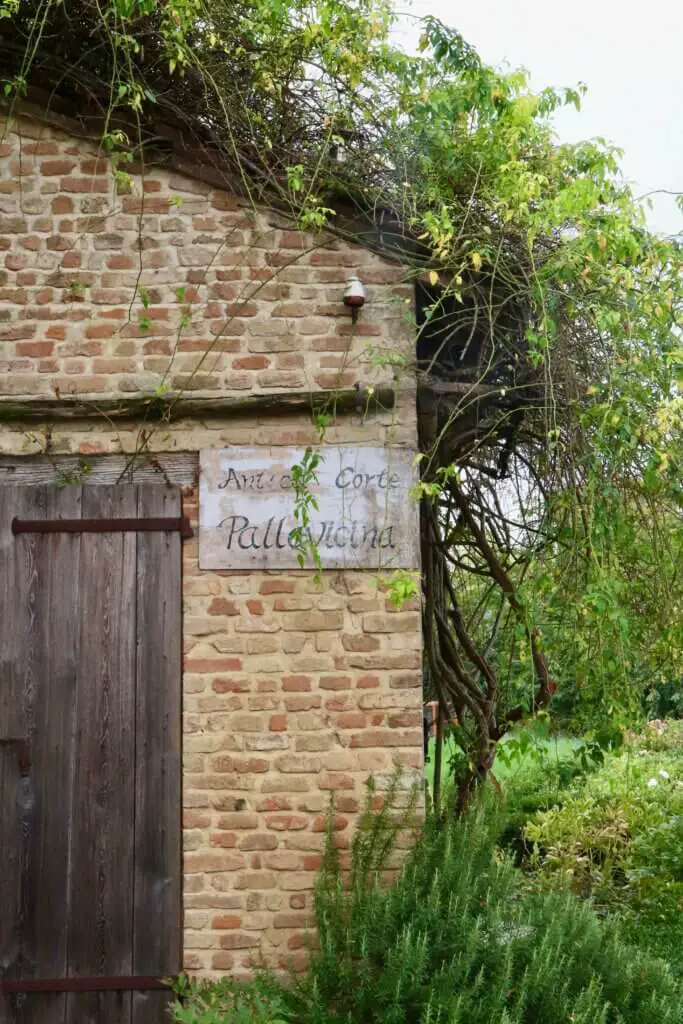
If you’ve never heard of culatello (or culatello di Zibello) before, you’re not alone. It wasn’t until 2017 that this delectable cured meat was approved for import to the United States, and it’s still well under the radar for most people across the globe. But for those in the know, even prosciutto pales in comparison to this delicious pork product.
Part of the reason that culatello is such a well-kept secret is that it is exclusively produced in a tiny part of Emilia-Romagna. This is because the curing of the meat is entirely dependent on the cool, foggy, humid microclimate found only in the lowlands near the Po River.
Antica Corte Pallavicina is located a stone’s throw from the Po and is not only a culatello producer but also features a Michelin-starred restaurant, an hosteria, and an eleven-room relais, or luxurious country guesthouse.
And the property is just gorgeous.
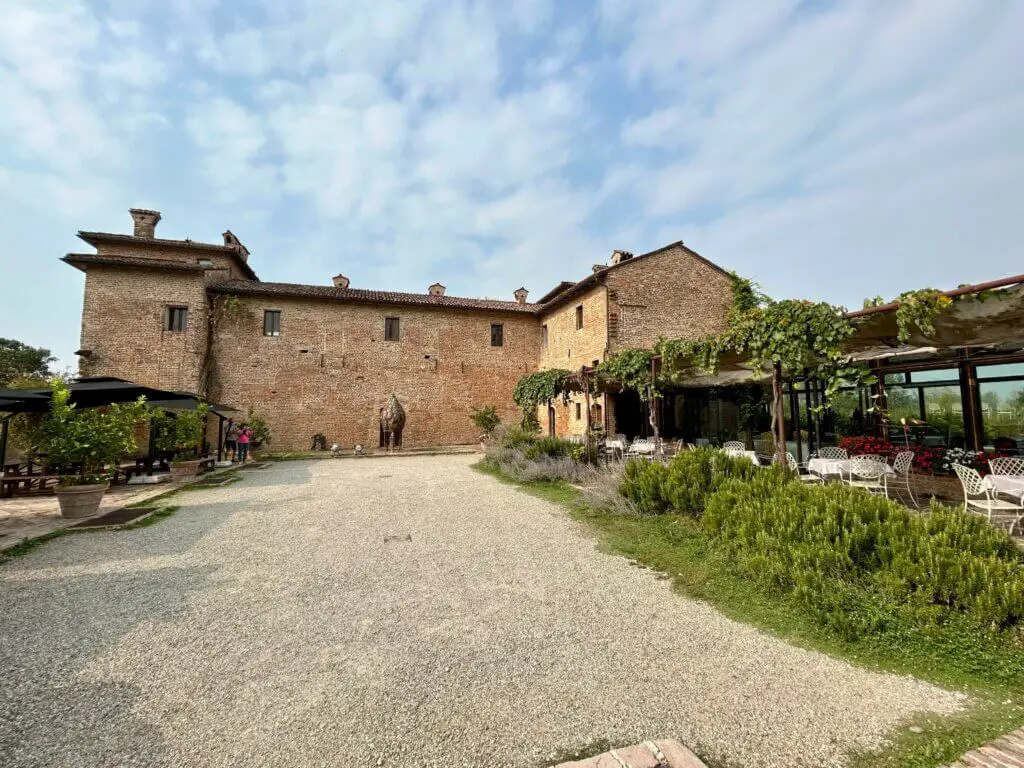
It’s a pretty special experience to step inside a medieval estate and come face-to-face with a row of Michelin awards…
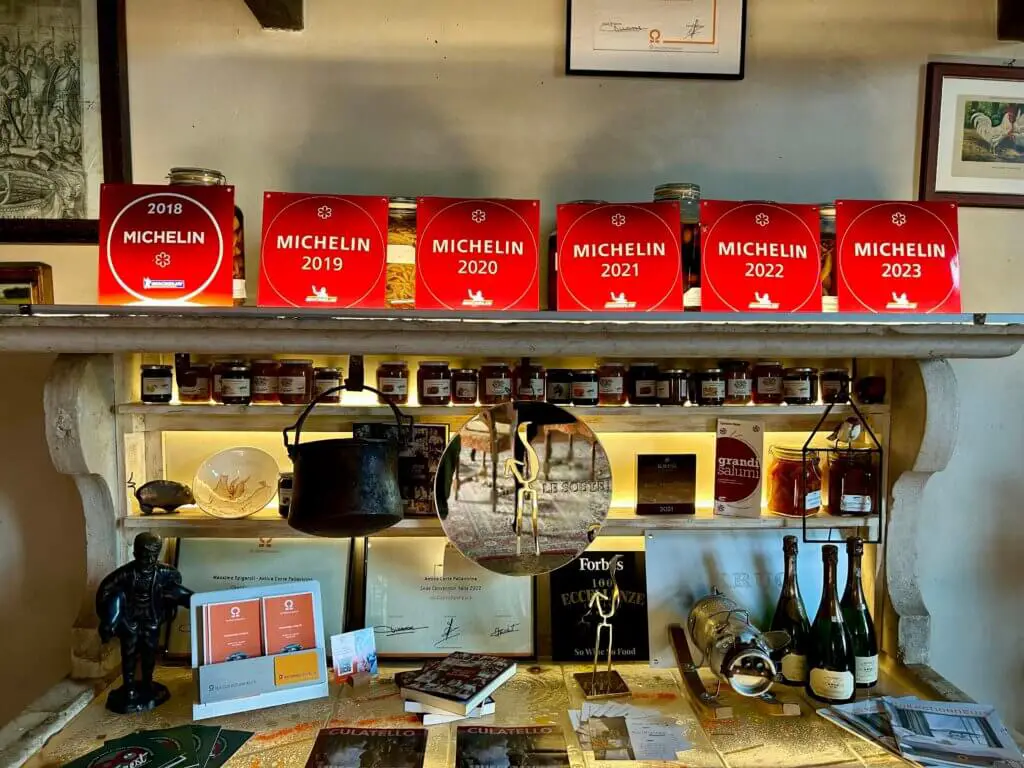
… but perhaps even more unique to descend into the 14th-century cellar and find yourself surrounded by hundreds of hanging, curing cuts of meat.
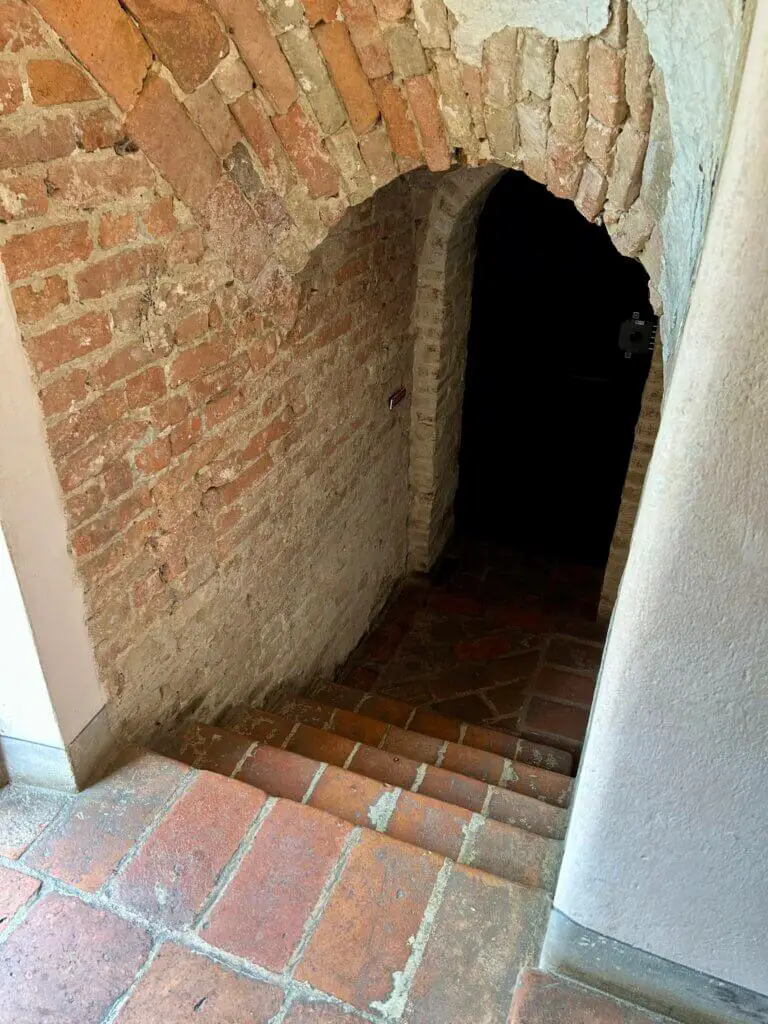
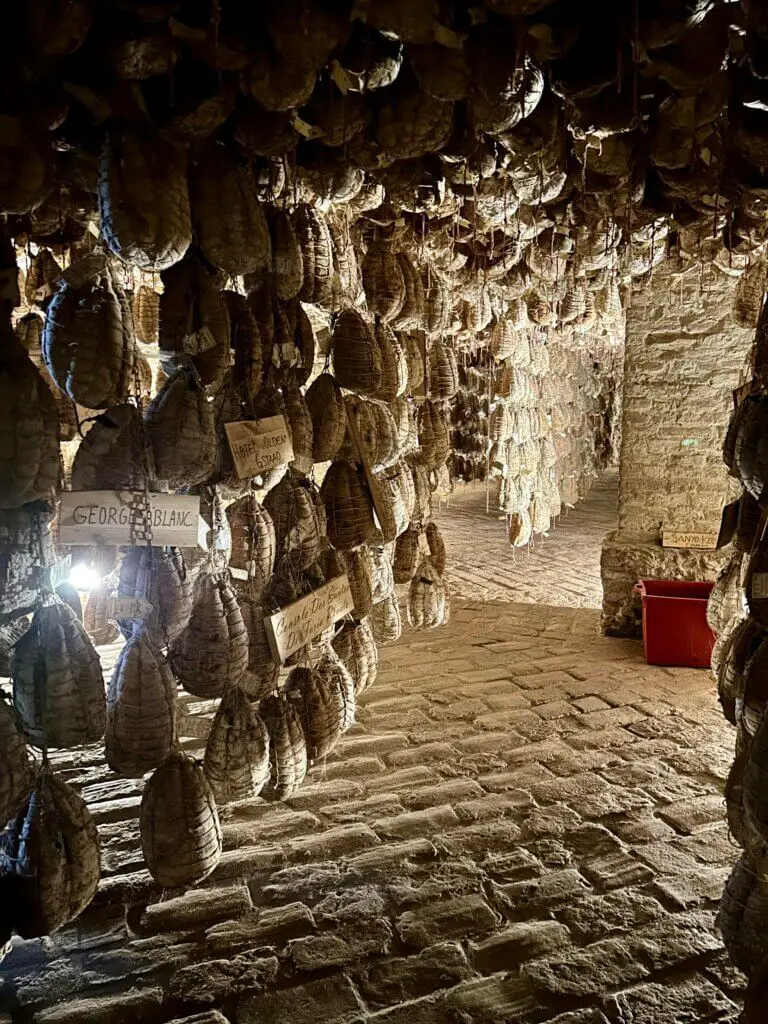
Culatello comes from pigs’ thigh muscles, from which the choicest cuts are trimmed, seasoned, and salted before being enclosed in the pig’s bladder and secured with a net of hand-tied ropes. These porcine packages are then hung in the cellar for at least ten months to cure in the cool, humid air.
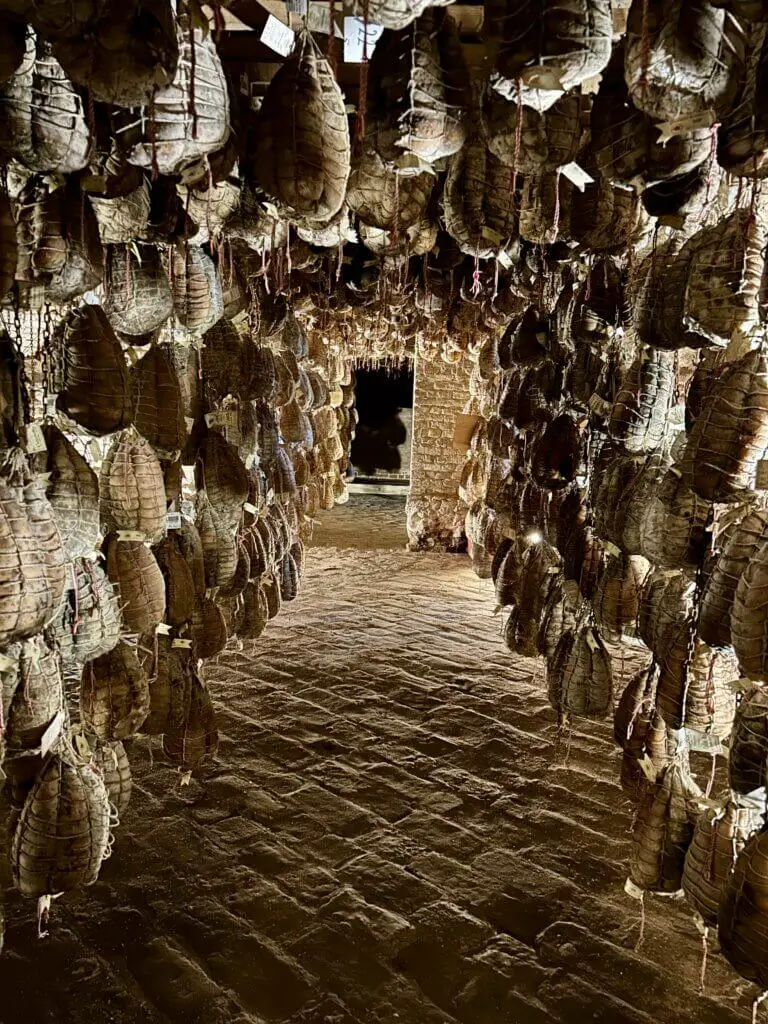
Many of the culatelli are labeled with the person or restaurant to which they are specifically designated to be sold or given. The list of names is impressive, and includes such notable persons as King Charles of the United Kingdom and Prince Albert of Monaco.
Culatello is no joke.
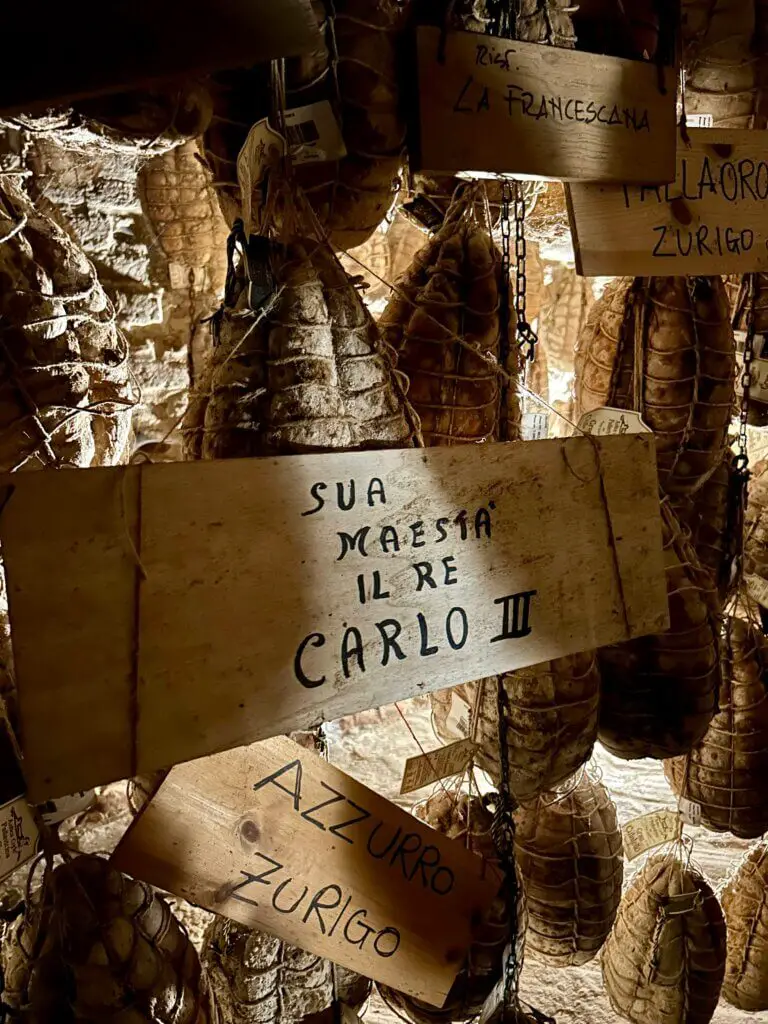
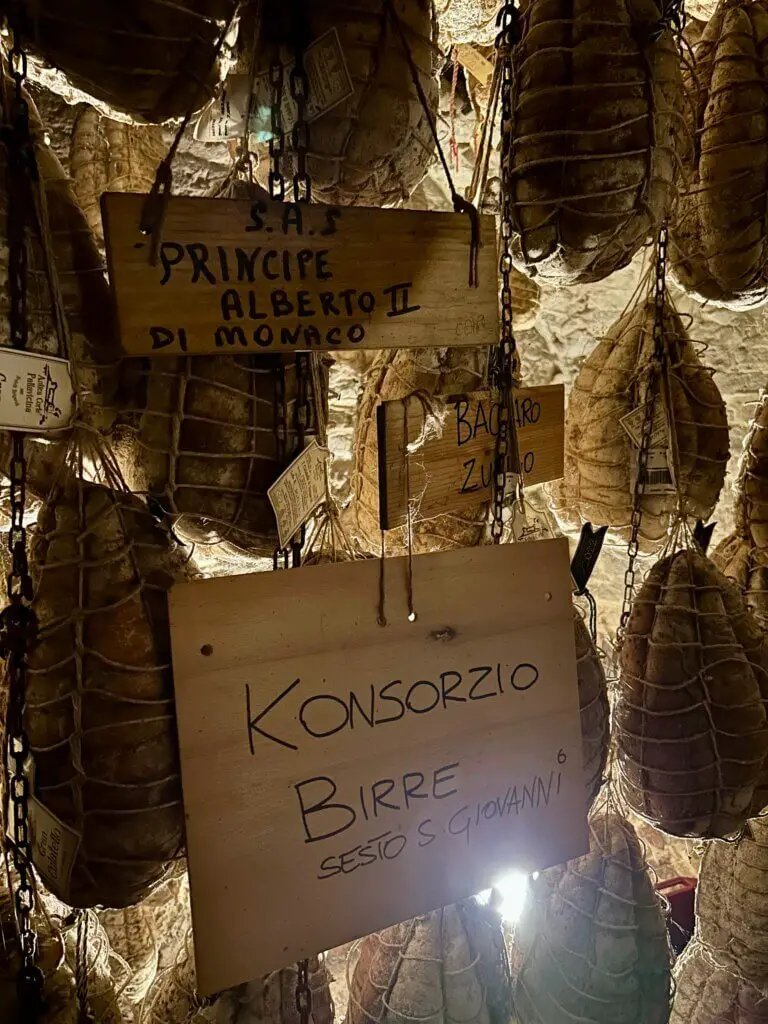
After touring the cellars and learning all about the culatello-making process from Monica, we stepped back into the sunlight to sample the goods.
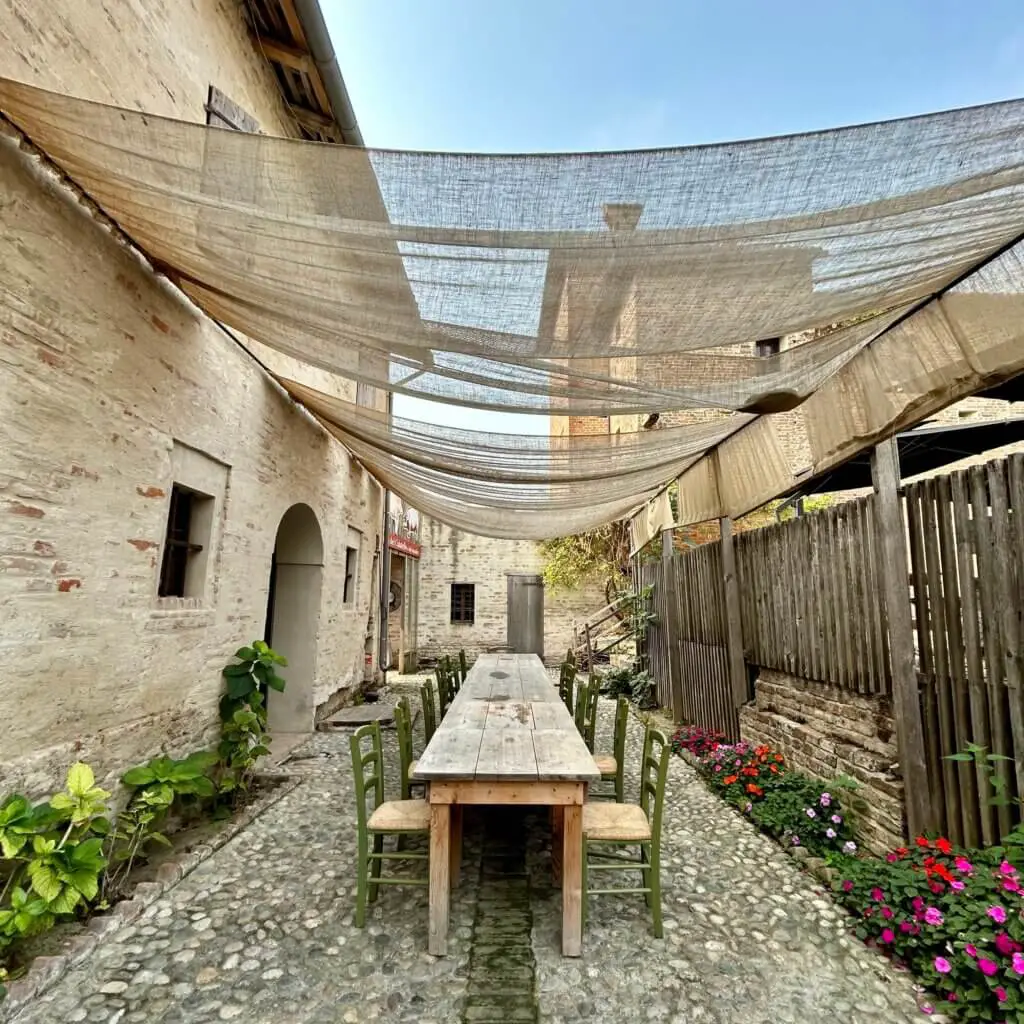
We cozied up at a little wooden table outside the hosteria, where we were treated to a board of cured meats, homemade bread, and bowls – not glasses – of Lambrusco wine. A sparkling red from Emilia-Romagna, Lambrusco is served in little bowls because at one time wine used to be considered a food. Farmers traditionally even mixed it with hot broth and pasta!
Our meat board also featured pancetta, prosciutto, and two types of salami, but there was no doubt that the culatello was the star of the show. A little bit of cured meat can go a fair distance with me, but I couldn’t get enough of it. The depth and rich complexity of the flavor, the melt-in-your-mouth texture… it was easy to see why people pay the big bucks for this special product.
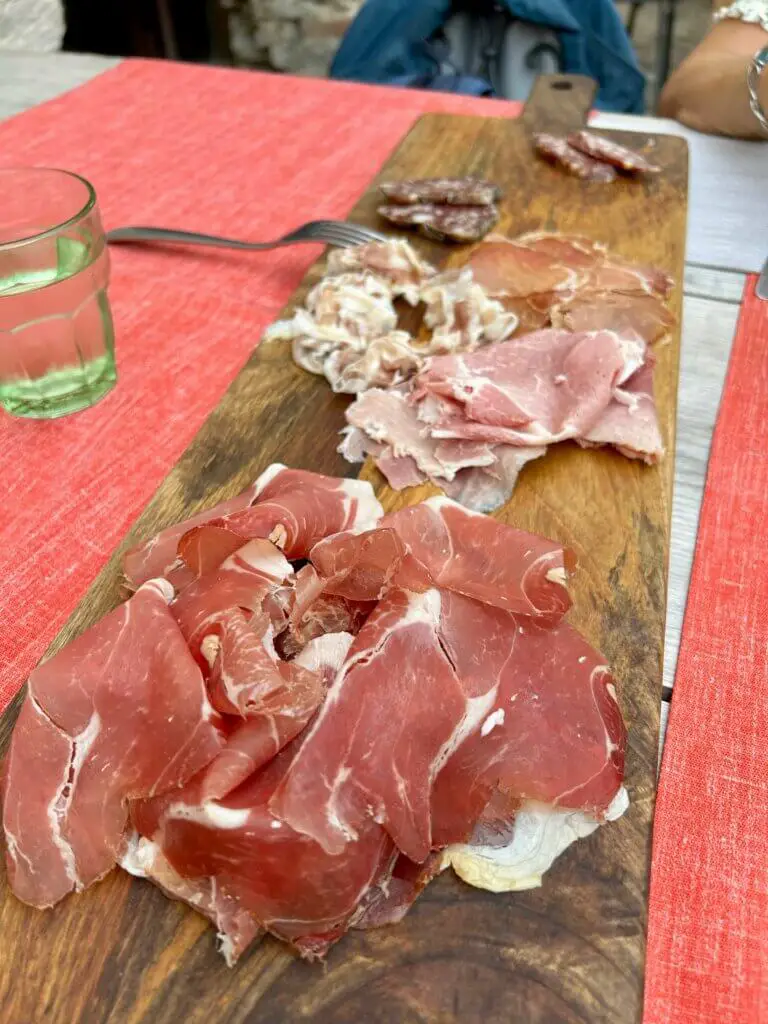
After a thoroughly enjoyable – and filling – repast and conversation with Monica, we were glad to have an hour’s drive to the next stop on our Parma food tour. Not only did we get to see more of the Emilia-Romagnan countryside, but it gave us a chance to digest in preparation for our next treat!
Quick Photo Stop: Castello di Torrechiara
It wasn’t officially a stop on our Parma food tour, but Monica was kind enough to pull us over for a great view of the 15th-century Castello di Torrechiara, or Torrechiara Castle.
This massive hilltop fortress, located about a half hour south of Parma, had been slowly taking shape on the horizon as we drove. We were delighted to be able to stop and admire it for a moment or two.
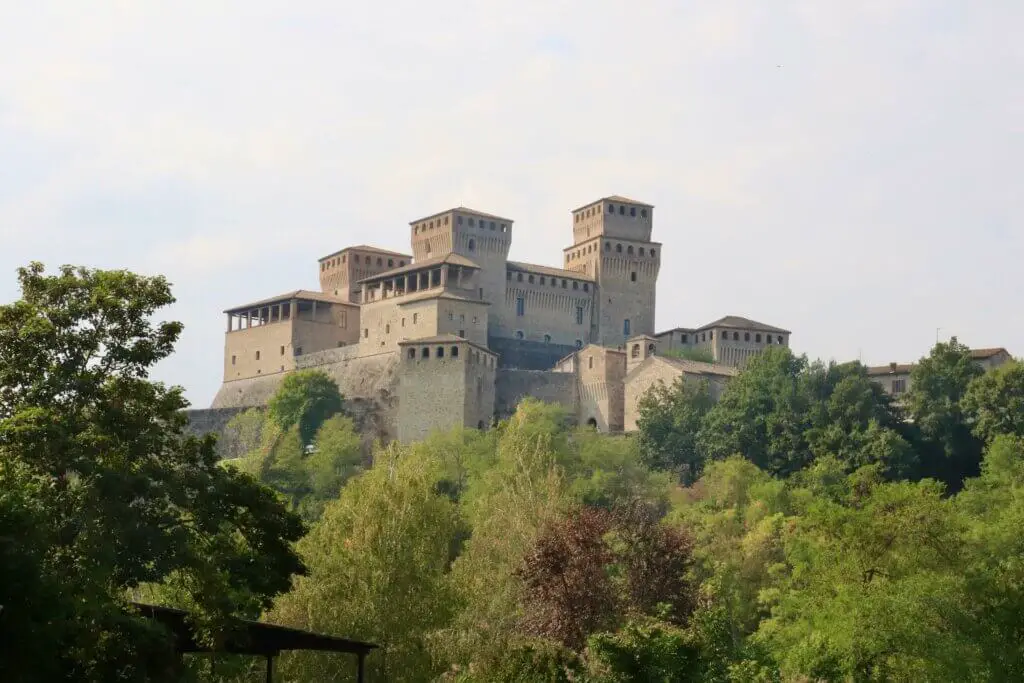
Stop 3: Malvasia Wine
No food tour of Emilia-Romagna would be complete without a stop at a winery, and the views couldn’t have been much better from this one. We left the flat, industrial plains of Parma behind and found ourselves in rolling, vineyard-clad hills. Perched atop one of them was the lovely Cantine Dall’Asta.
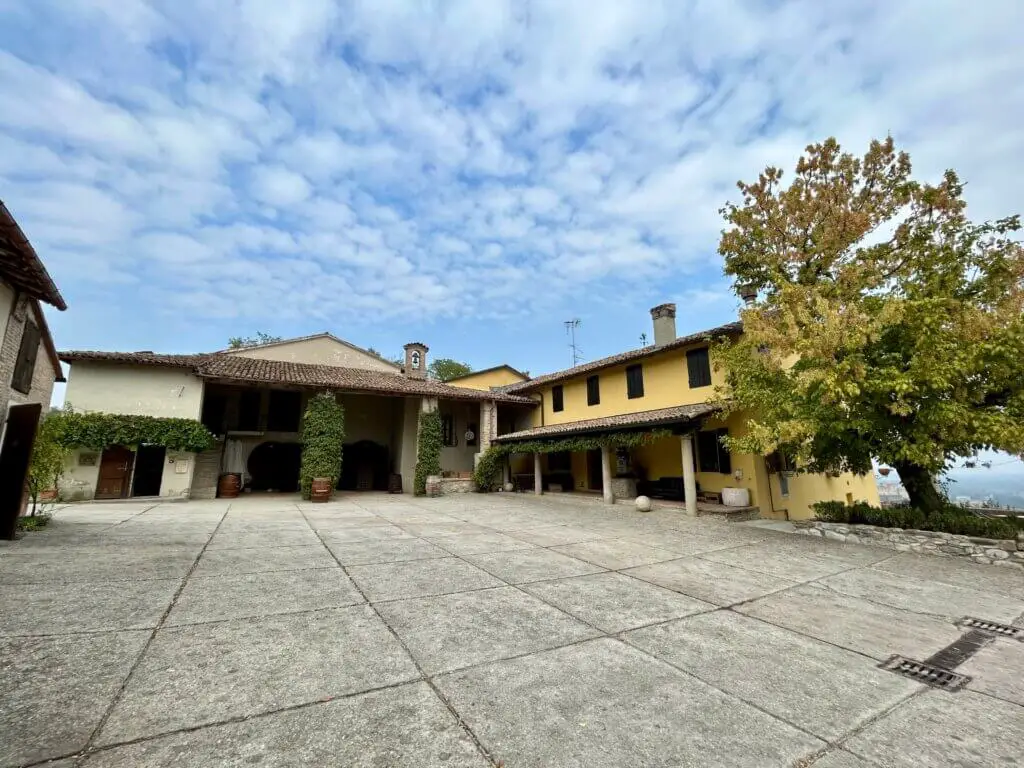
Cantine Dall’Asta has been making wine for over a hundred years, and some of the property’s wine cellars date to the 1500’s. We got to check out those cellars, which were lined with bottles tilted at an angle to help create a sparkling effect as they aged. I personally couldn’t get over how the racks were constructed by laying bottles across thin wooden slats – it seemed so precarious! At the same time, though, I loved the adherence to tradition.
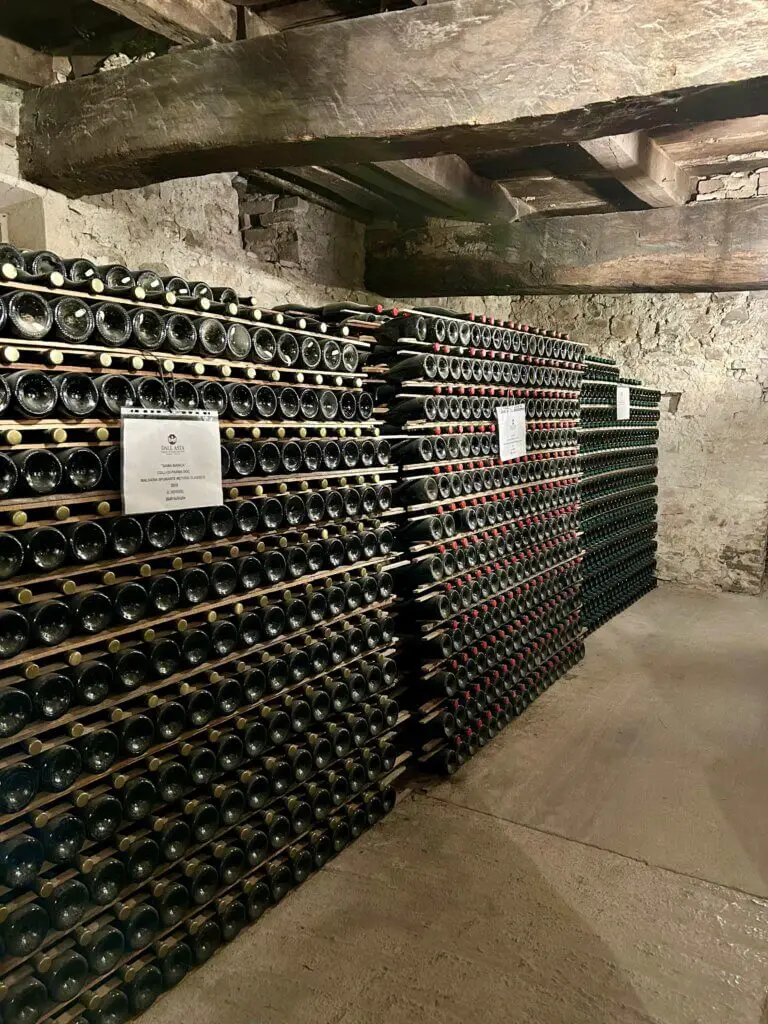
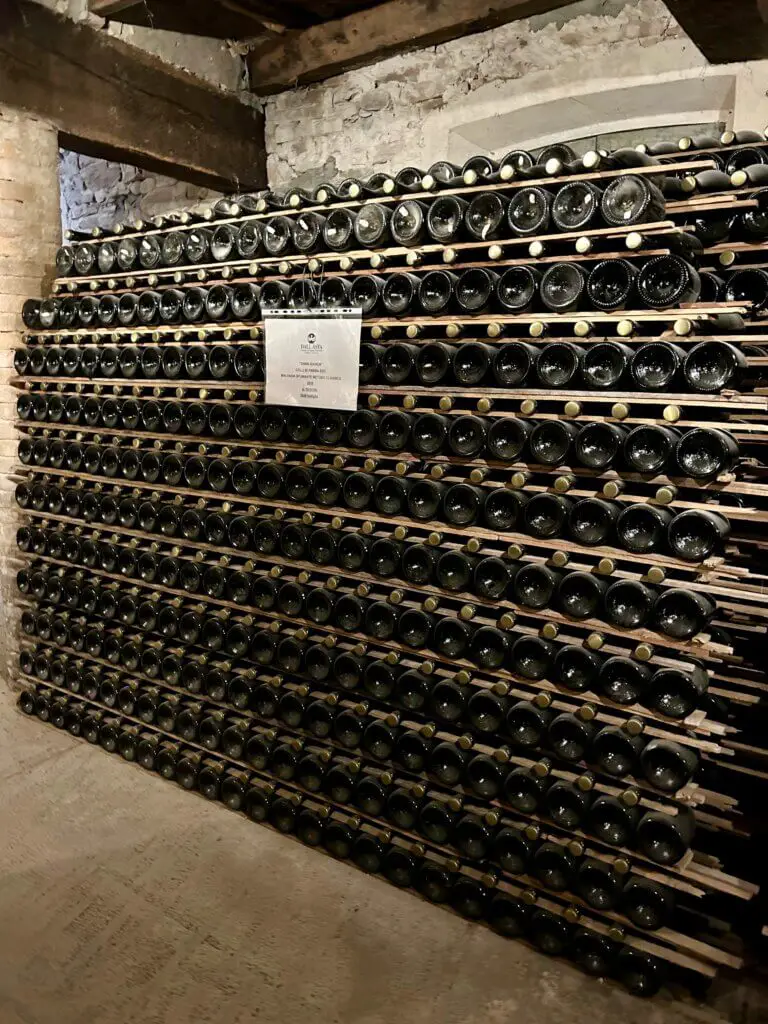
I’ll admit that, while it’s always interesting to hear how wine is made and Cantine Dall’Asta uses a variety of traditional and modern techniques, the real delight of visiting this particular winery was the gorgeous view from the terrace. Green hills undulated away before us, and the Castello di Torrechiara sat proudly at the center of the scene.
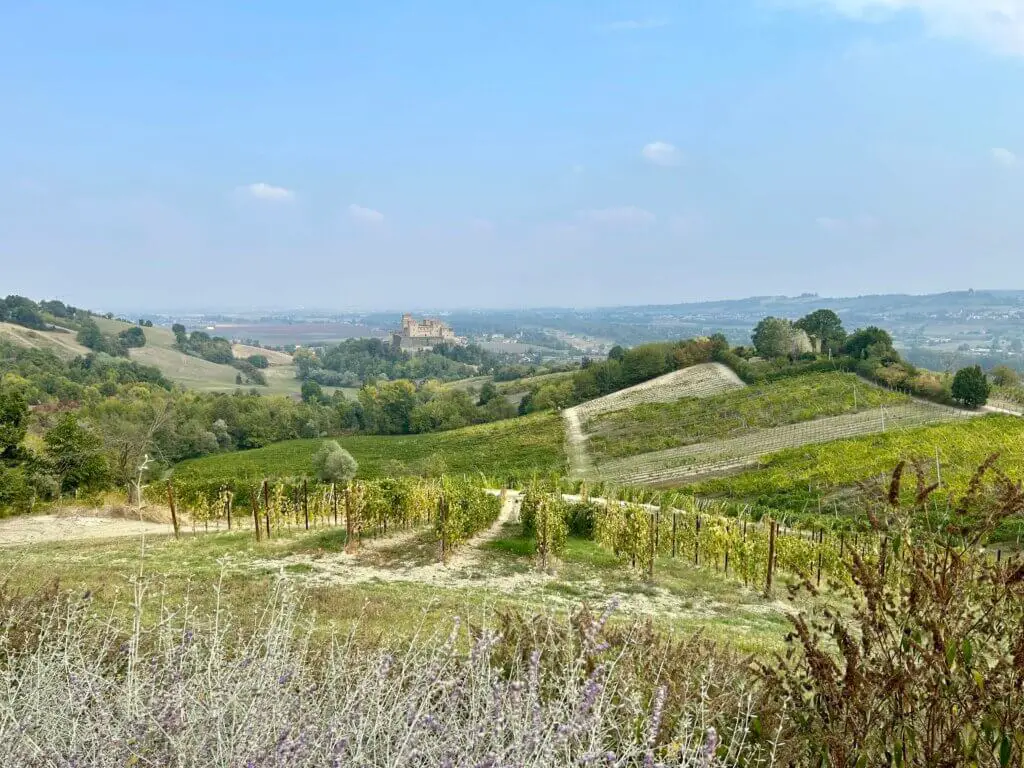
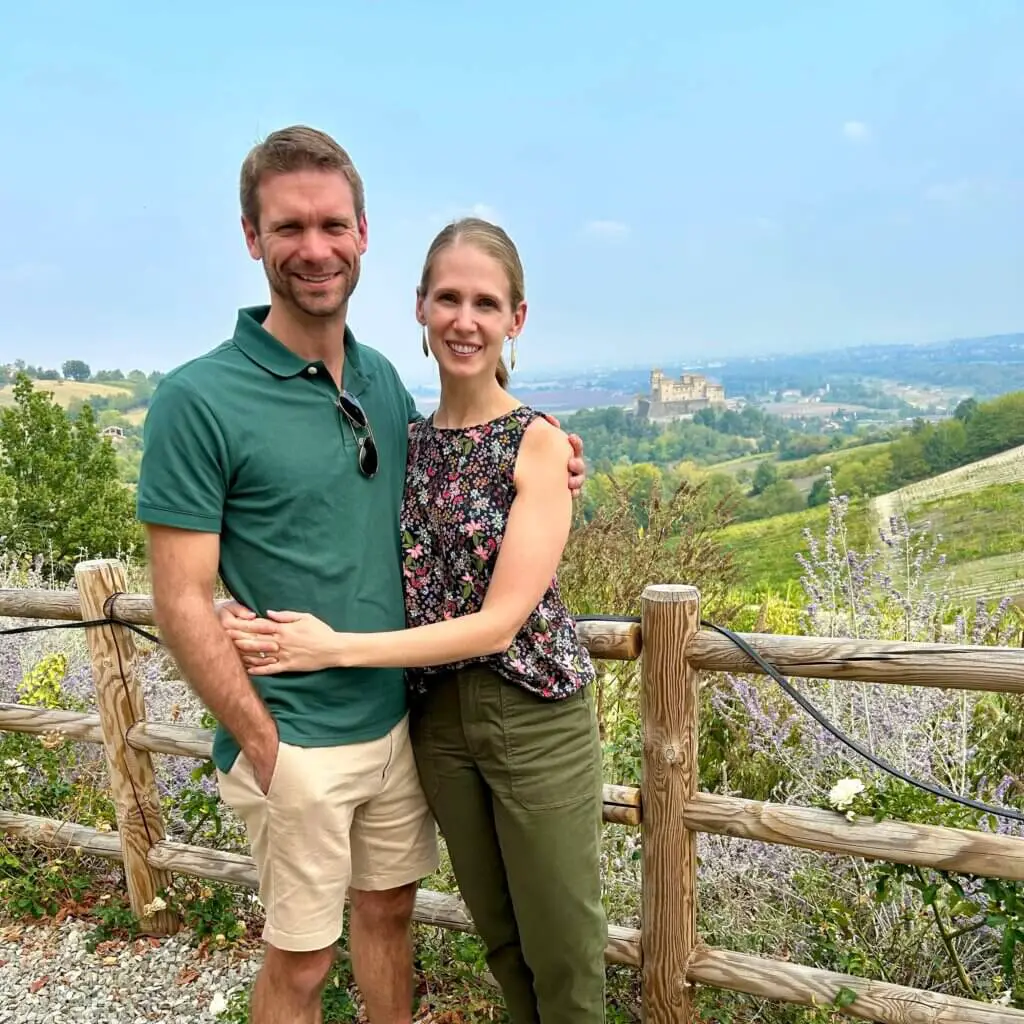
Sipping delicious Malvasia CDO wine in the Italian countryside with a genuine castle in the background… that’s the stuff of dreams. We could have lingered in the warm October air for hours just drinking in the sights and the vintages. In fact, this was the only stop on our Big Fives Parma food tour where we felt a little rushed.
I mean, who would want to leave?
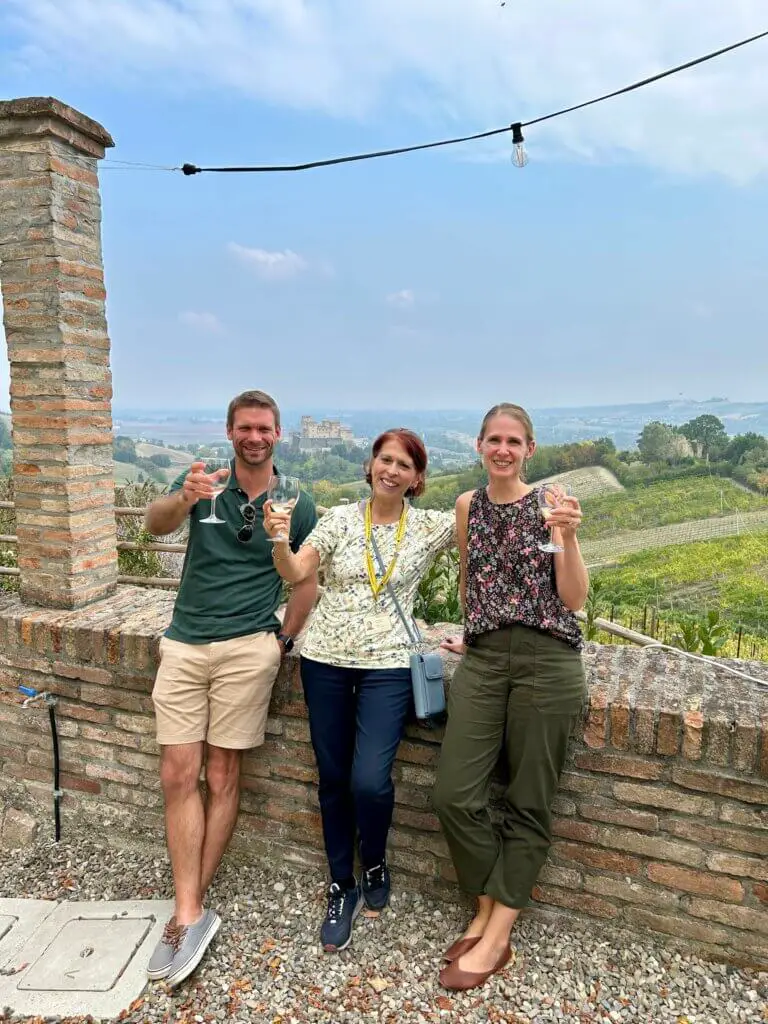
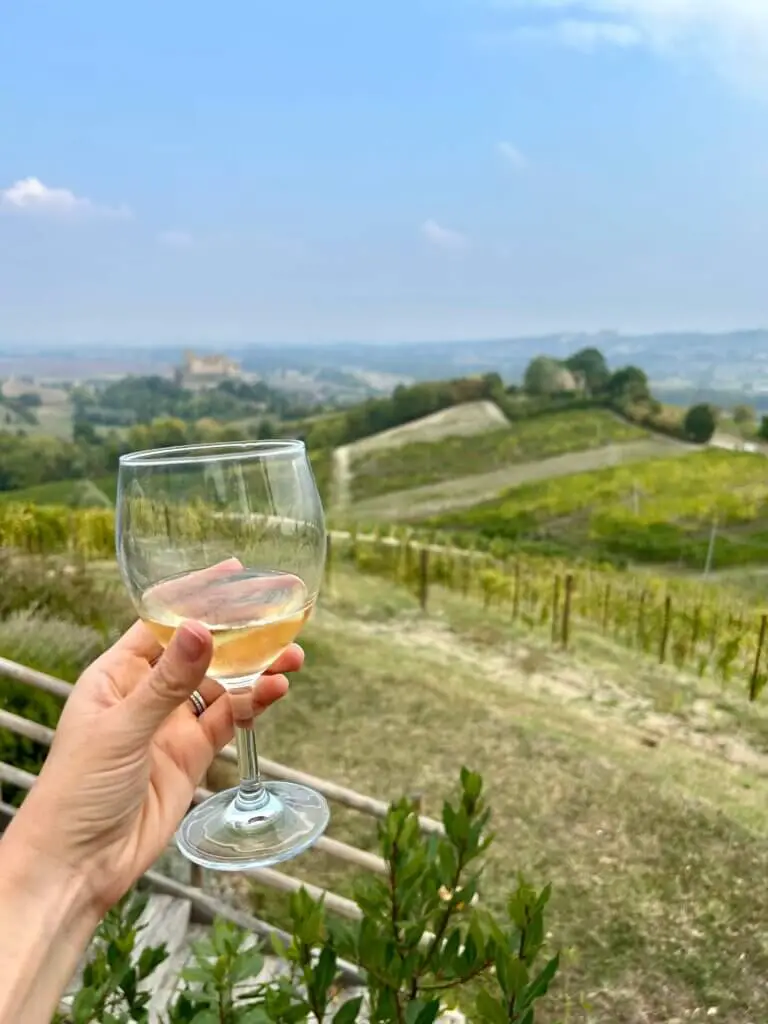
Stop 4: Prosciutto
Thankfully, however, there was more delicious food in store. Next up was a visit to Salumificio Conti, a family-owned (and largely women-run) producer of prosciutto/Parma ham. Rather like our visit to the Parmigiano-Reggiano co-op, this stop was another factory tour. Once again clad in a devastatingly attractive set of hair nets, gowns, and booties, we followed Monica through the factory as she explained the many steps necessary to create this world-famous cured meat.
We saw where the hams were salted and chilled…
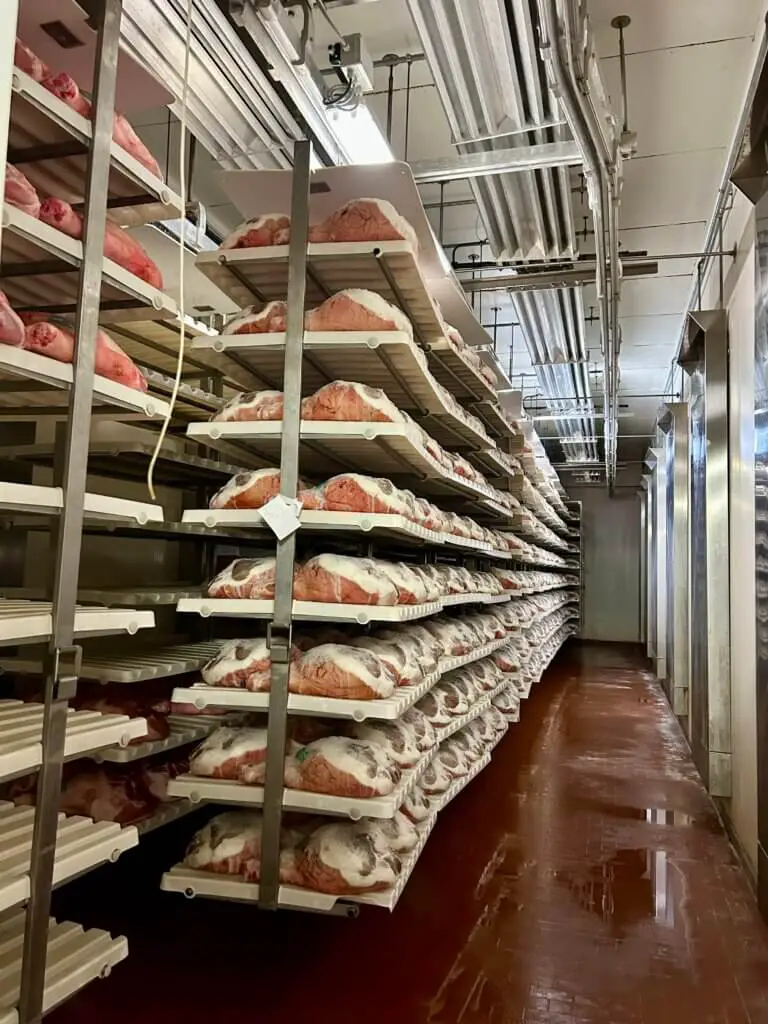
Where they were hung to cure in the cool Emilia-Romagnan breezes (strategically let in through tall windows), and where the ends are greased to assist in the curing process.
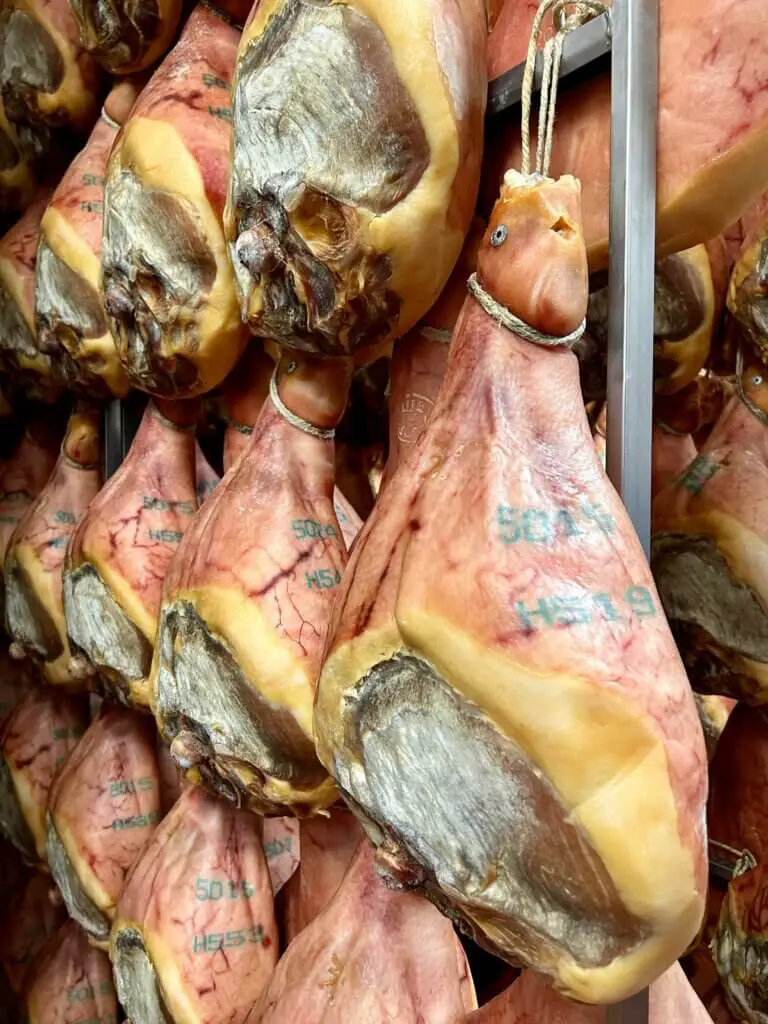
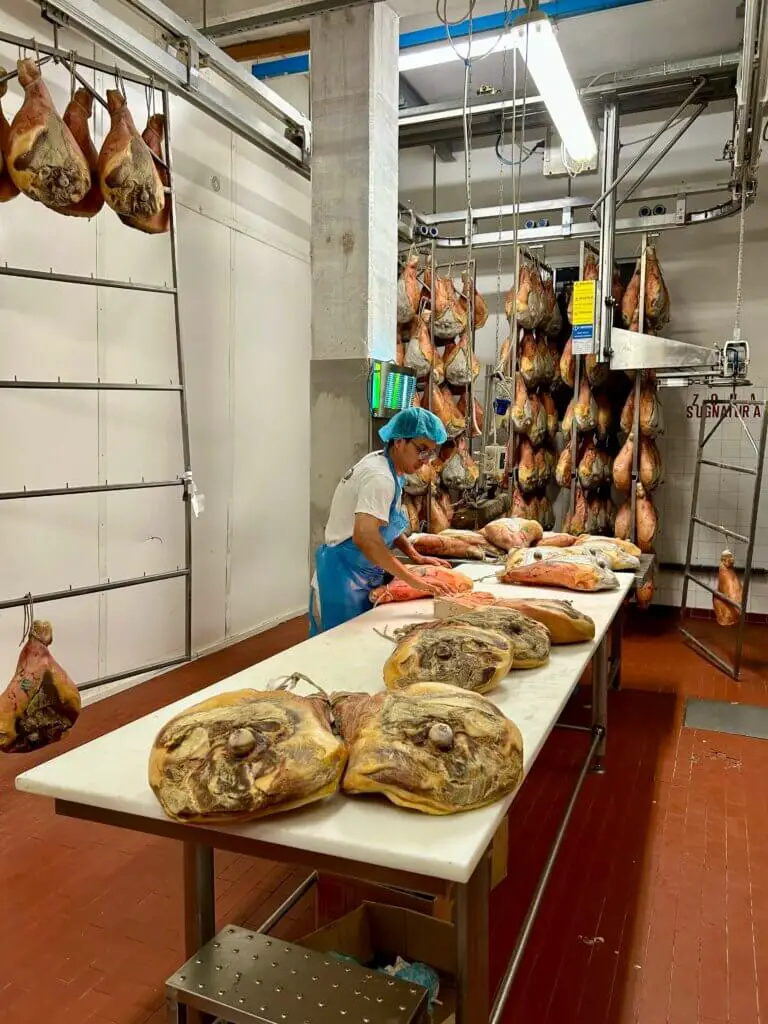
I’ll tell you what – I have never seen so many hams in all my life. They were hanging everywhere! Vegans beware – this is not the stop for you.
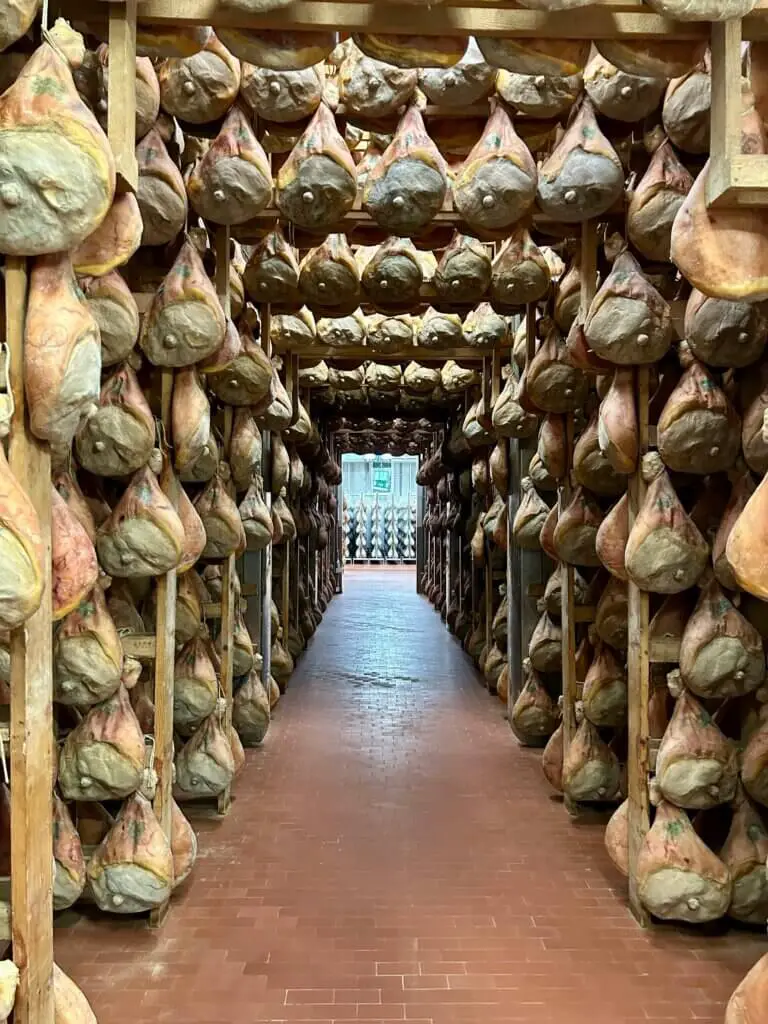
After we made our way through the factory, we were of course treated to a sampling of the excellent Conti prosciutto (and wine, naturally). And it was, of course, delicious.
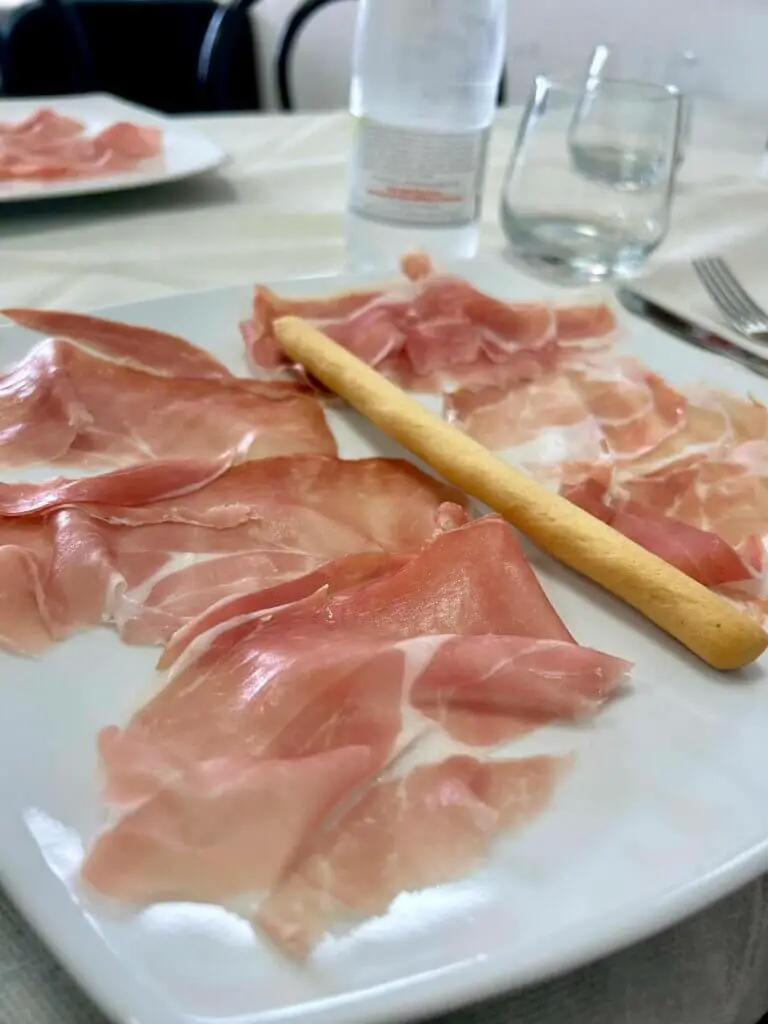
Unfortunately, Salumificio Conti was our final stop of the day with our intrepid guide, Monica, since at our last destination we would be hosted by the owner. We were so grateful for her information, her extremely professional guidance, and her company throughout the day and were sad to see her go!
Stop 5: Balsamic Vinegar
Our final destination was a family-run balsamic vinegar operation, Tenuta Medici Ermete. The Medici family have been making wine and balsamic vinegar for five generations, and stepping onto the 19th-century property feels like traveling back in time.
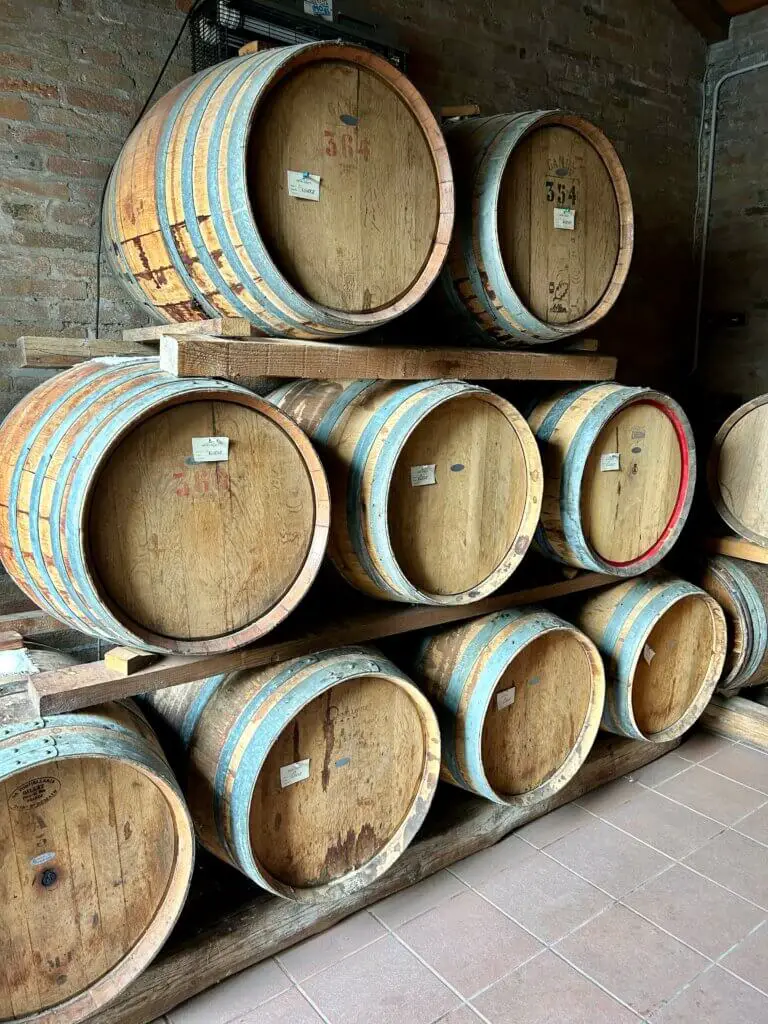
You access Medici Ermete by turning onto a lane that takes you through rows and rows of grape vines. At the center is a complex of square, tan-colored buildings where people have lived and worked the land for generations. It really feels like living history, especially with all the antique farm and winery equipment scatted about.
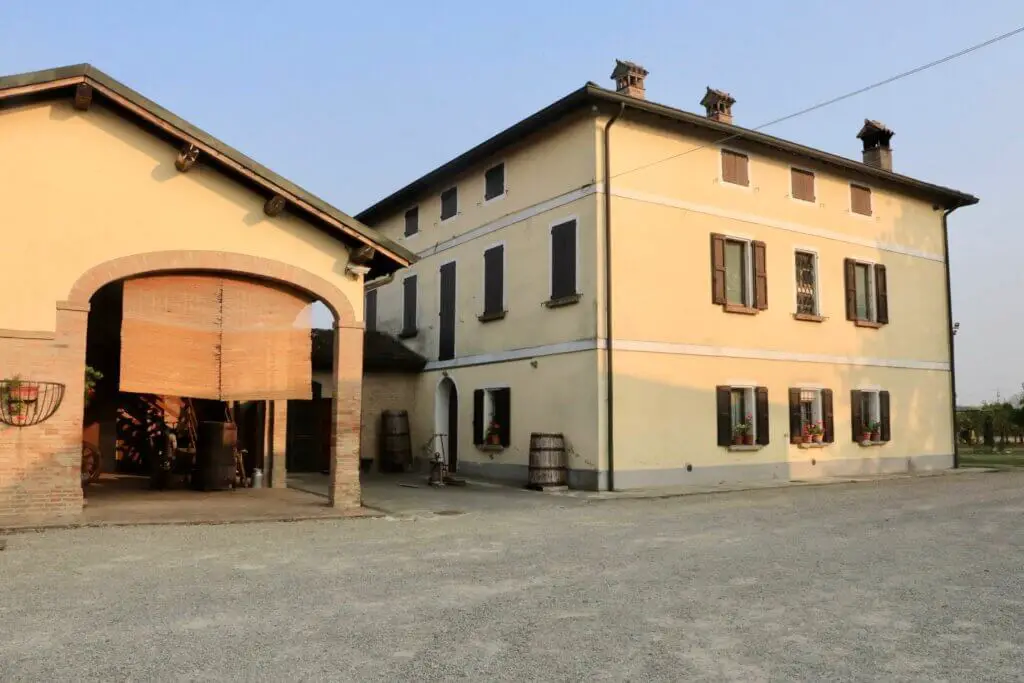
Upon our arrival, we were greeted by Alessandra, a fourth-generation member of the family. She led us across the property with a deep but quiet pride. I just loved getting to learn about this process from someone so passionate and profoundly connected to it.
Most of the balsamic vinegar aging is done in an upstairs, attic-like room, which is accessible by climbing a flight of well-trodden wooden steps.
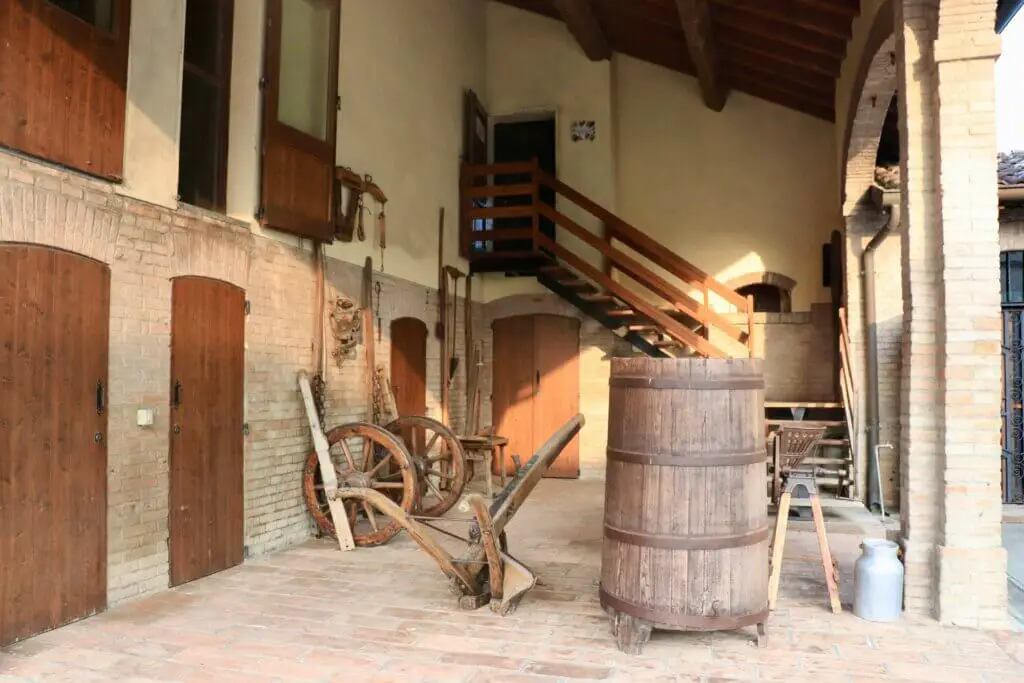
Once inside, you are surrounded by the tempting aroma of aging vinegar and dozens of barrels of all sizes and types of wood. Alessandra explained the process of crafting balsamic vinegar, including the effect that the different woods have on the taste of the final product.
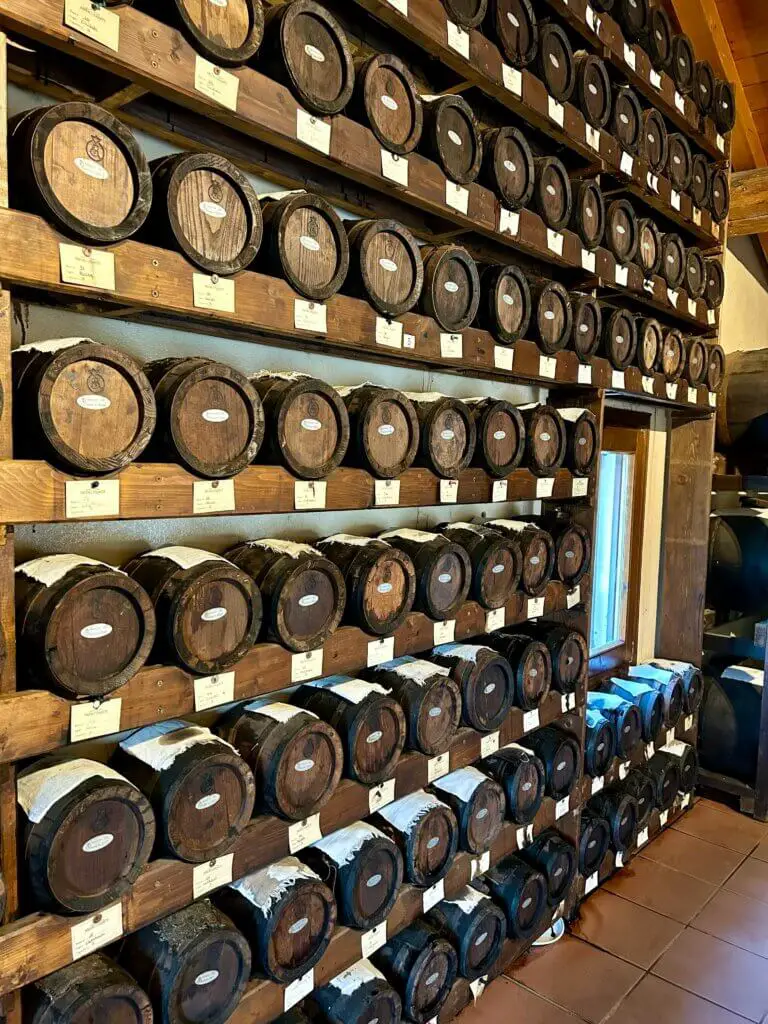
She also explained how each child born into the family is gifted a set of vinegar-making barrels, which I thought was such a beautiful way of passing along the family tradition. Walking into the room below, we could see the names of Medici family members adorning the racks.
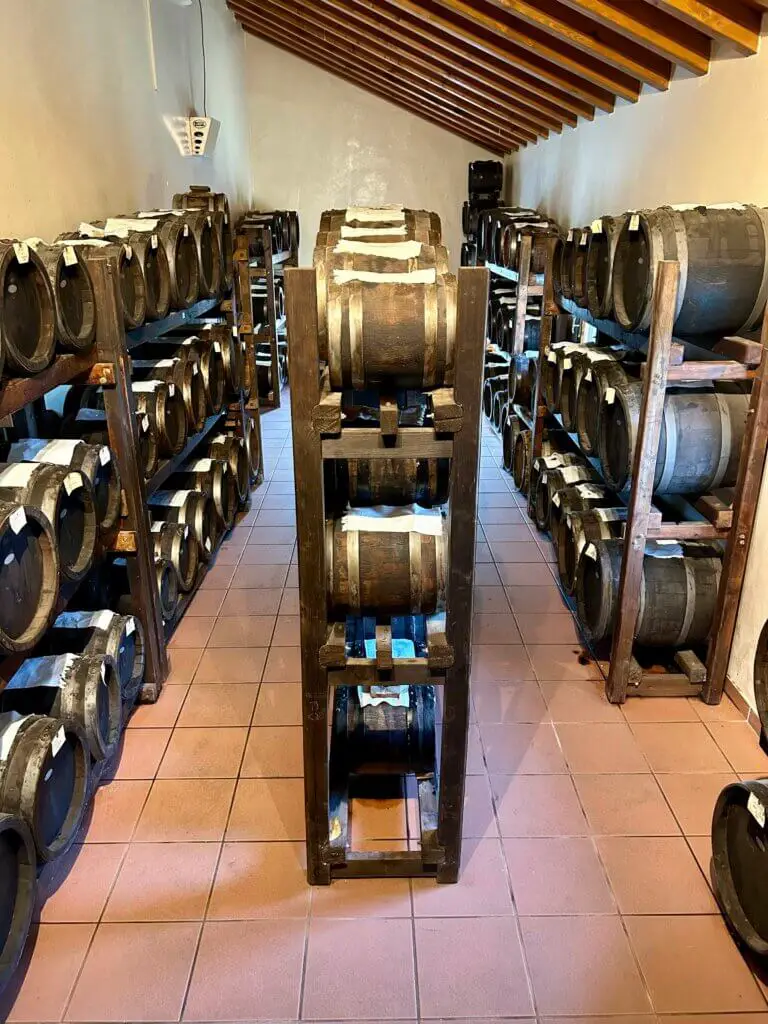
After our tour of the vinegar attic, it was time to taste the finished product. Alessandra poured us spoonfuls of vinegar that had been aged for 12-20 years, 20-25 years, and more than 25 years, and goodness me. I don’t know if you’ve ever tasted real, high-quality balsamic vinegar before, but it is life changing. There’s absolutely no comparison to the bottles you buy at the grocery store to use in cooking. It’s so sweet and complex and sits so decadently on the tongue.
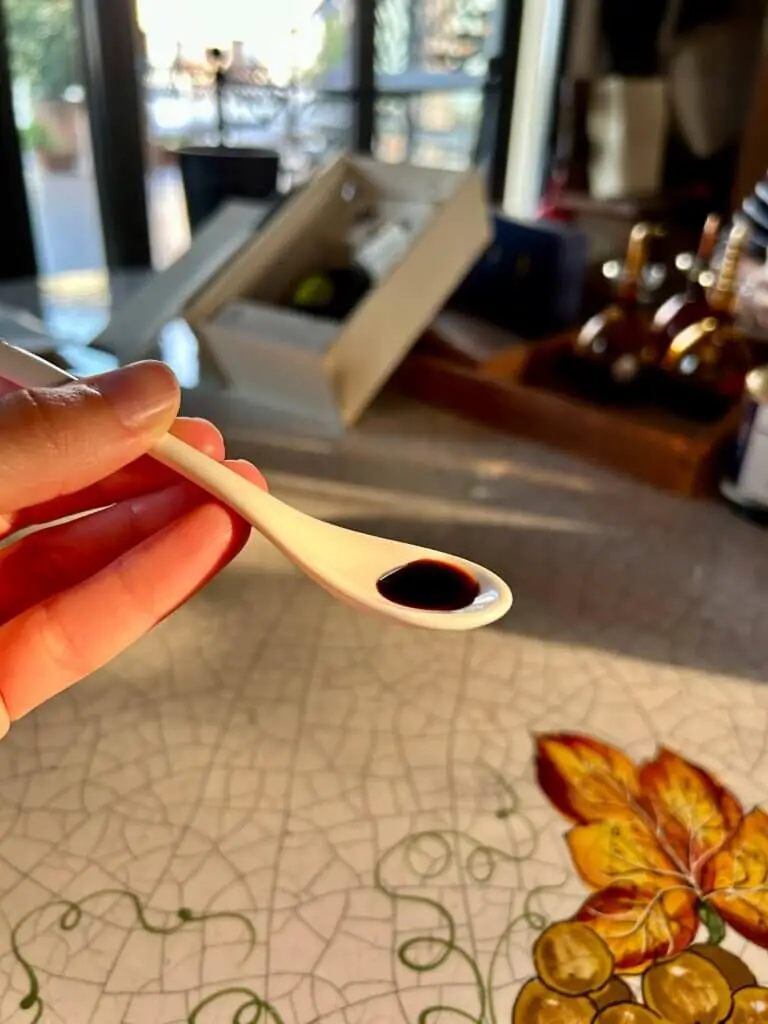
In Conclusion
M and I couldn’t have asked for a better, more comprehensive introduction to Emilia-Romagnan cuisine than our full-day food tour from Parma. The quality and craftsmanship was obvious in every food we sampled, and it was fascinating to see the work and tradition that goes into making each product. Monica was a fantastic guide, and Food Valley Travel did a great job in structuring the experience.
If this full-day tour seems too robust for you, or if you’d prefer an experience where you’re sampling completed dishes rather than individual products, there are plenty of shorter or differently-structured food tours and cooking classes in Parma. (Food Valley Travel also offers some great options.) Regardless of how you do it, though, you simply can’t leave Italy’s Food Valley without some sort of foodie experience!
Special thanks to Monica Vanin for correcting some errors in the original draft of this post and providing additional information where it was lacking!
Tips for Your Full-Day Parma Food Tour
- We loved the Big Fives food tour because it enabled us to experience so many different special foods from the region, but you should be aware that there is a lot of driving involved. The shortest distance between locations is about fifteen minutes, but all the others are at least forty minutes apart.
- Speaking of driving, there are two options available when booking your Big Fives tour. You can choose to have transportation included, or you can drive yourself. The latter is significantly less expensive, even to the point that it may be more economical to do a one-day car rental, if you don’t already have one, rather than paying for driving services. (Guides are not allowed to concurrently serve as drivers in Italy, so the additional cost is specifically for a driver to come along just to transport you.)
- Wear comfortable shoes that you don’t mind getting a bit wet and/or dirty. The floor at the Parmigiano-Reggiano co-op is often wet, and you’ll also be walking over some uneven and potentially muddy terrain.
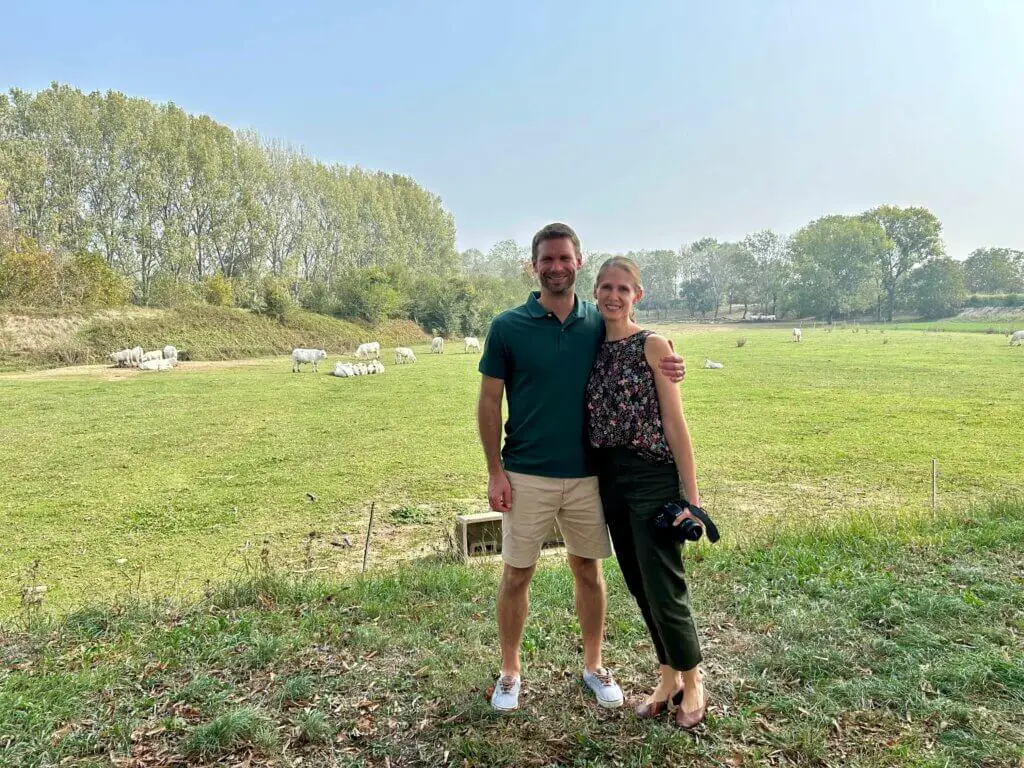
- Antica Corte Pallavicina also offers cooking classes, and where better to learn the art of Italian cooking?
- You’ll get plenty of views of the Castello di Torrechiara traveling south along the SS655 highway, but taking a slight detour onto Strada Provinciale Pilastro (later Via Martiri Bernini) through the village of Torrechiara leads you to a couple of excellent photo spots. There’s less traffic, as well, so you can easily pull over for a moment to snap a picture or two.
- Cantine dall’Asta hosts lots of events and may be available to book for overnight stays. There are also other wineries and agriturismi (farm stays) in the area. If you have the opportunity to spend more time in this lovely corner of Emilia-Romagna, take it.
- Gratuities for tour guides are always appreciated.
Where to Stay in Parma for Your Food Tour
We used credit card points to book our stay at the Starhotels du Parc in Parma and had a good experience. The room and bathroom were both large and comfortable, the staff were friendly, and parking was available onsite. The historical center of Parma, with its beautiful buildings and delicious restaurants, was about twenty minutes away on foot, but the walk led you through the pretty Parco Ducale from which the hotel got its name.
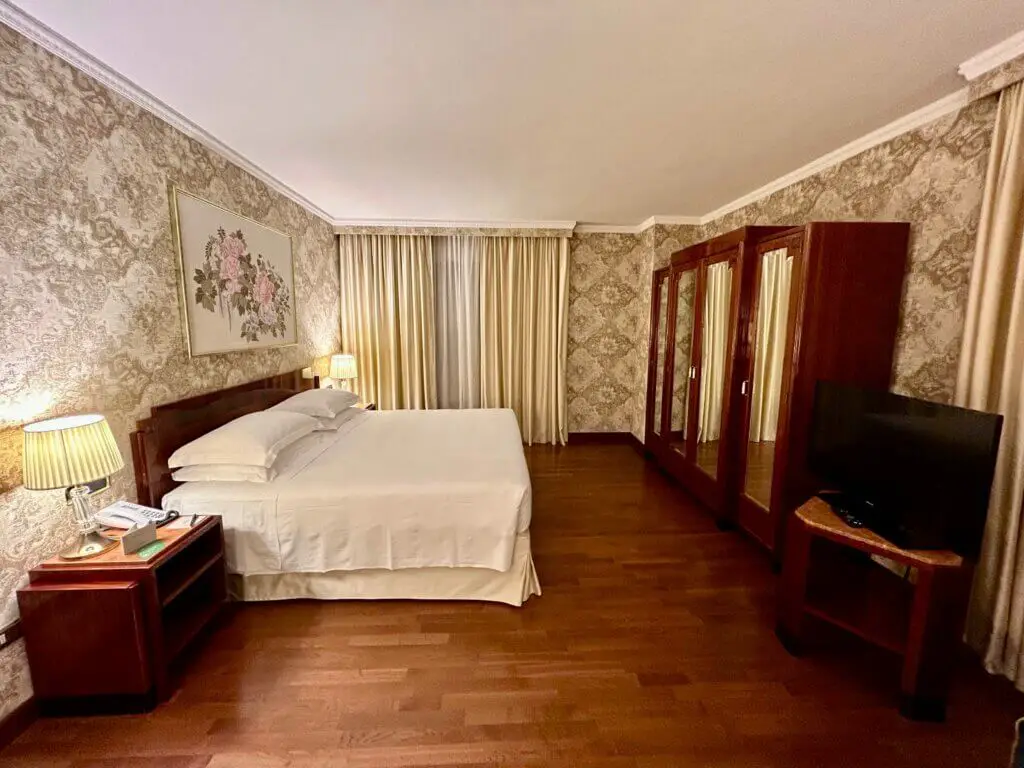
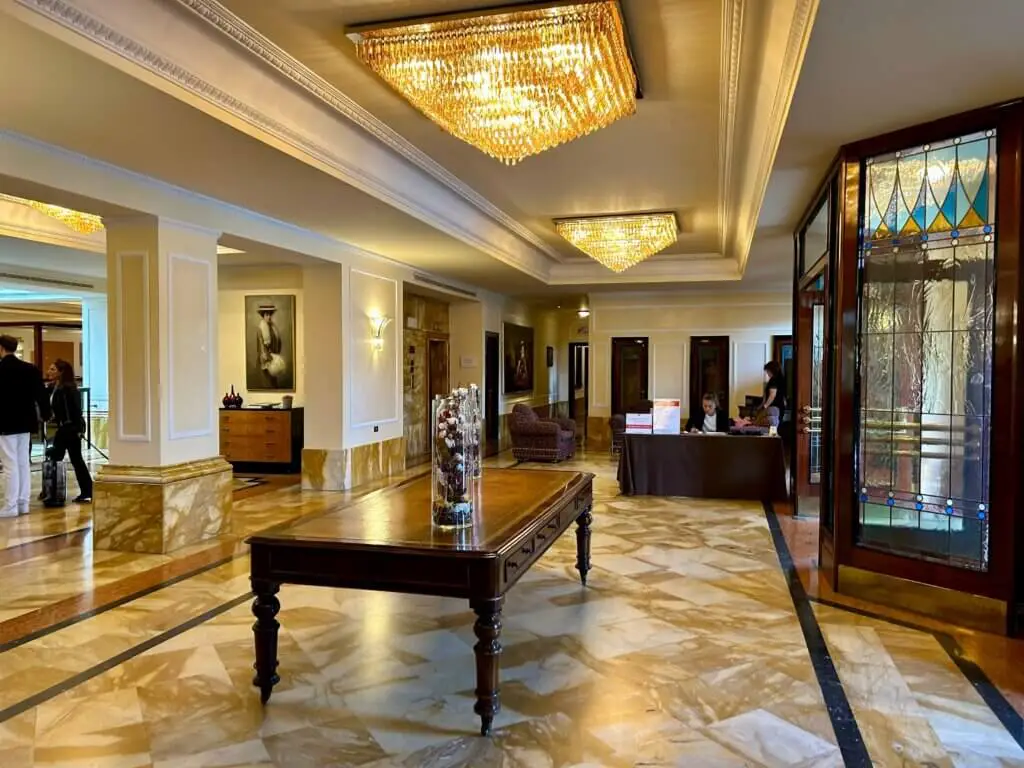
There are plenty of other places to stay in Parma, and choosing a hotel closer to the historic center obviously puts you closer to all the action. The Palazzo Dalla Rosa Prati is located right beside the Baptistry with views of the Parma Cathedral, and Opera Rooms and Breakfast is a charming B&B that travelers love.
With its rich history of food production, the Parma area is also an excellent spot to lodge at an agriturismo, or farm stay. Antica Corte Pallavicina and Cantine dall’Asta, above, are both agriturismi and host visitors overnight. The best place to find and compare agriturismi is on the official website, agriturismi.it.
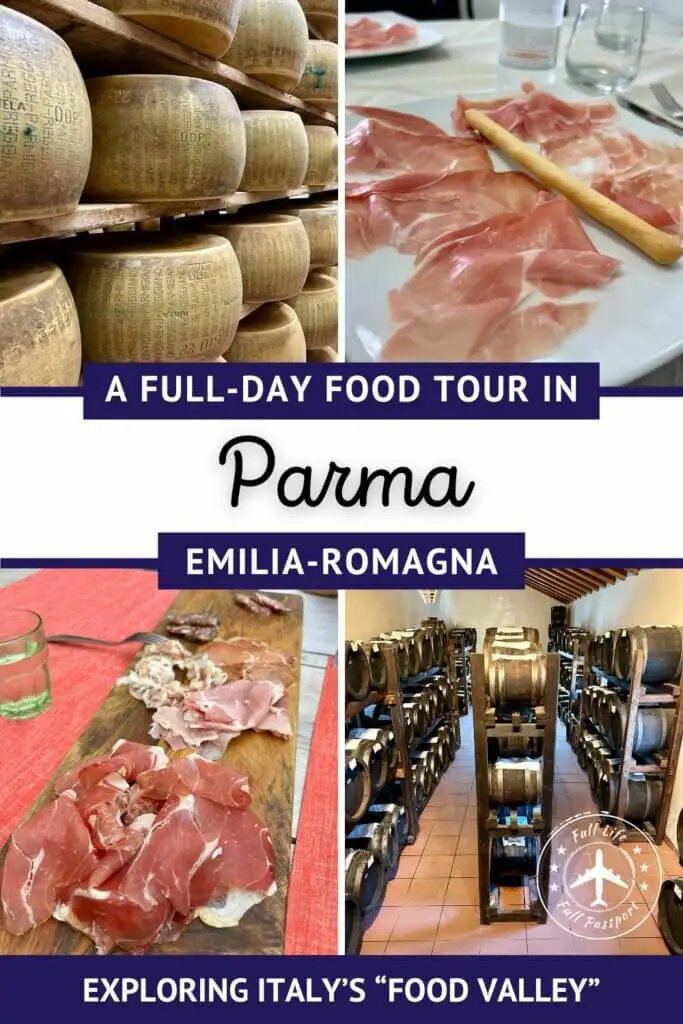
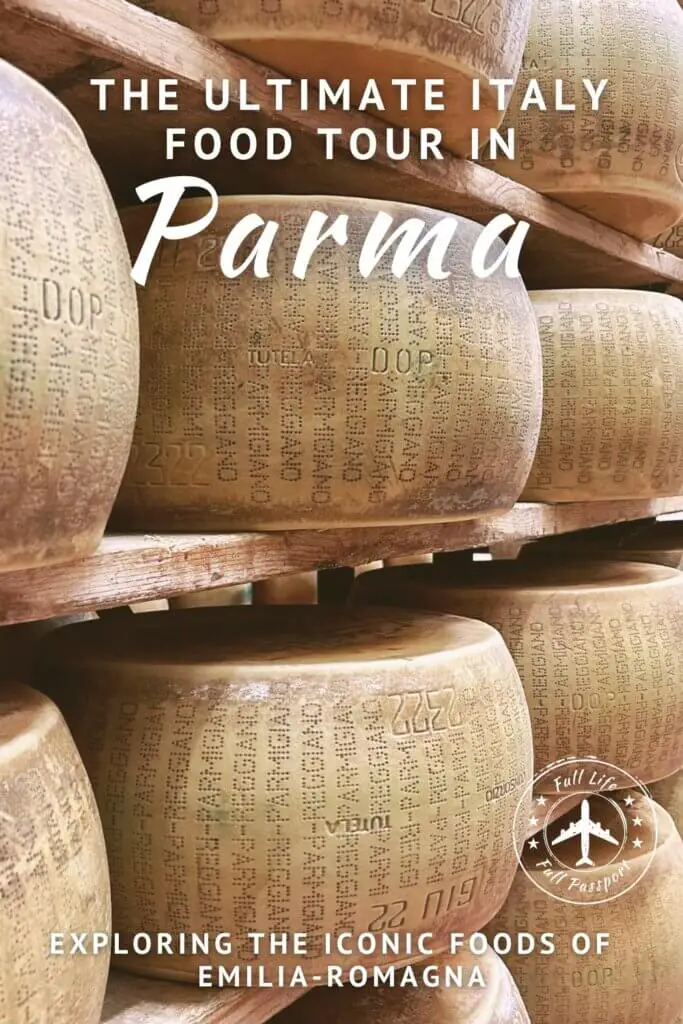
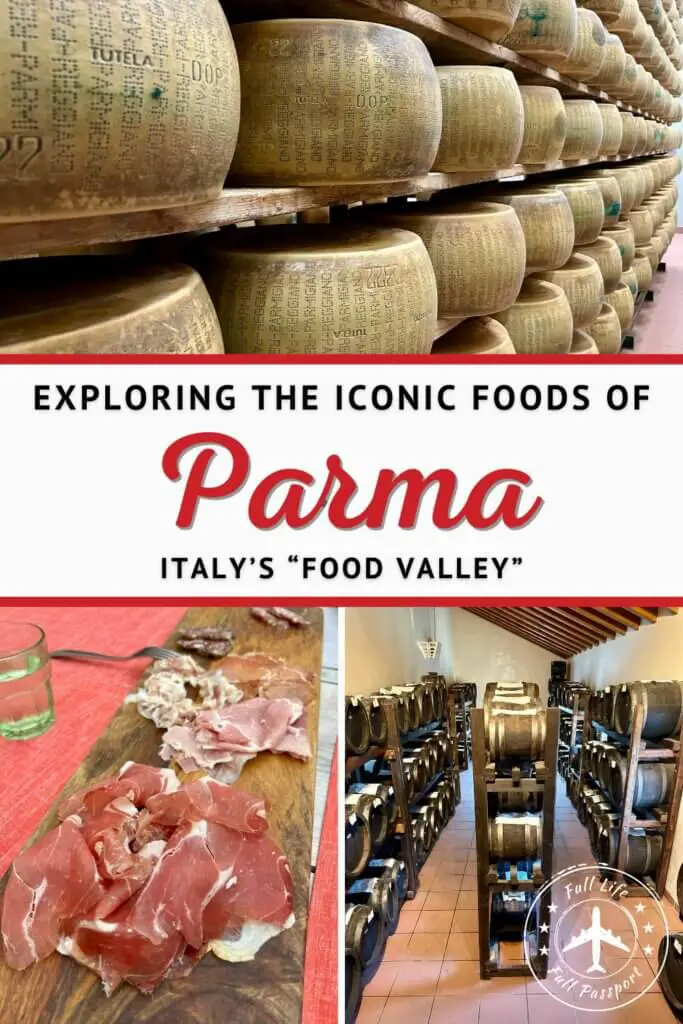
Like the post? Pin to save or share!
Read More:
Need some help planning your trip to Parma or Italy? Full Life, Full Passport offers customized planning services for all kinds of vacations and budgets!
Join Our Email Community!
Want to be the first to know when a new post is published, or to receive exclusive content directly to your inbox? Sign up here!
(We'll never sell your information.)
Awesome!
You have successfully joined our mailing list. Make sure to check your SPAM/junk mail if you don't hear from us soon.
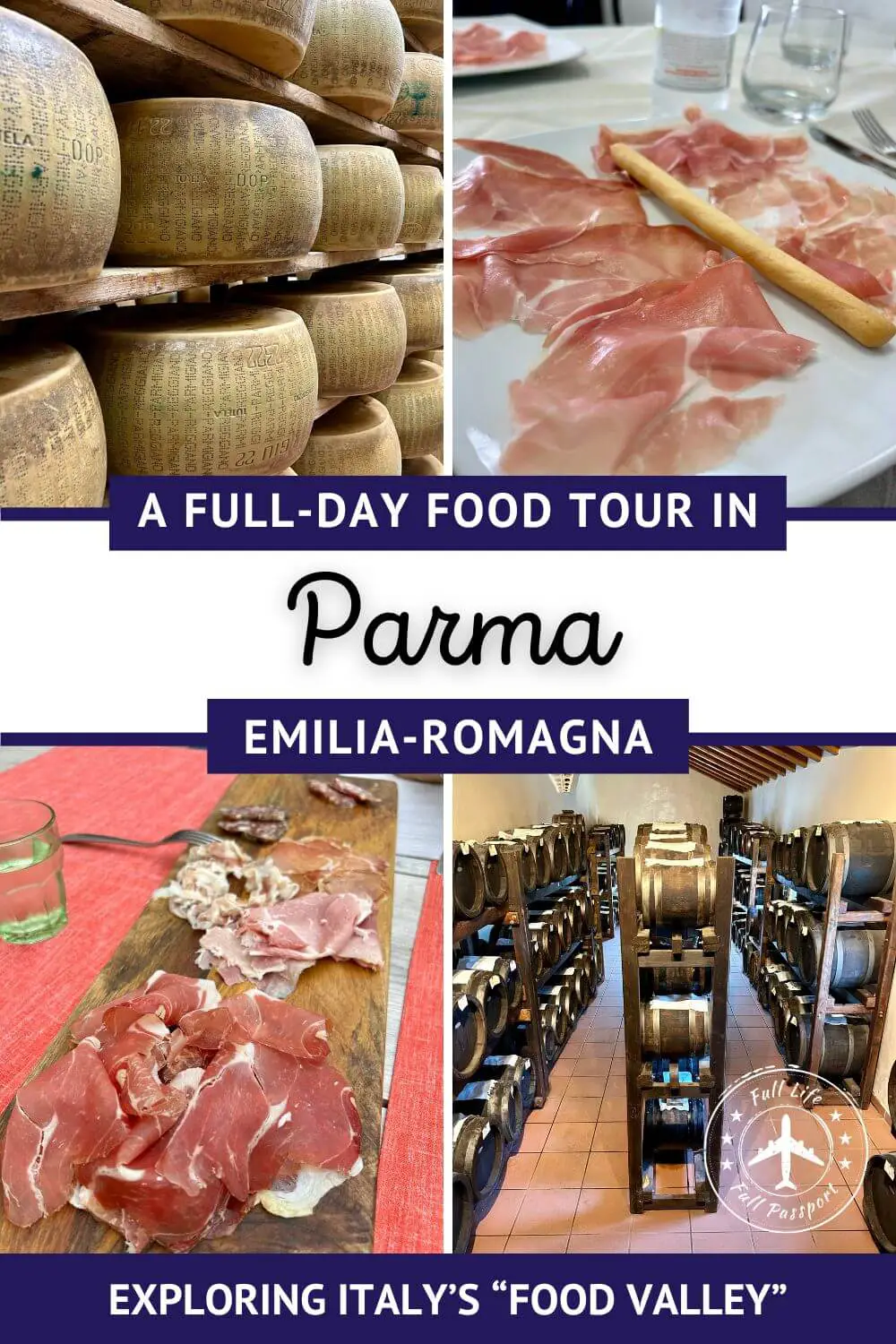
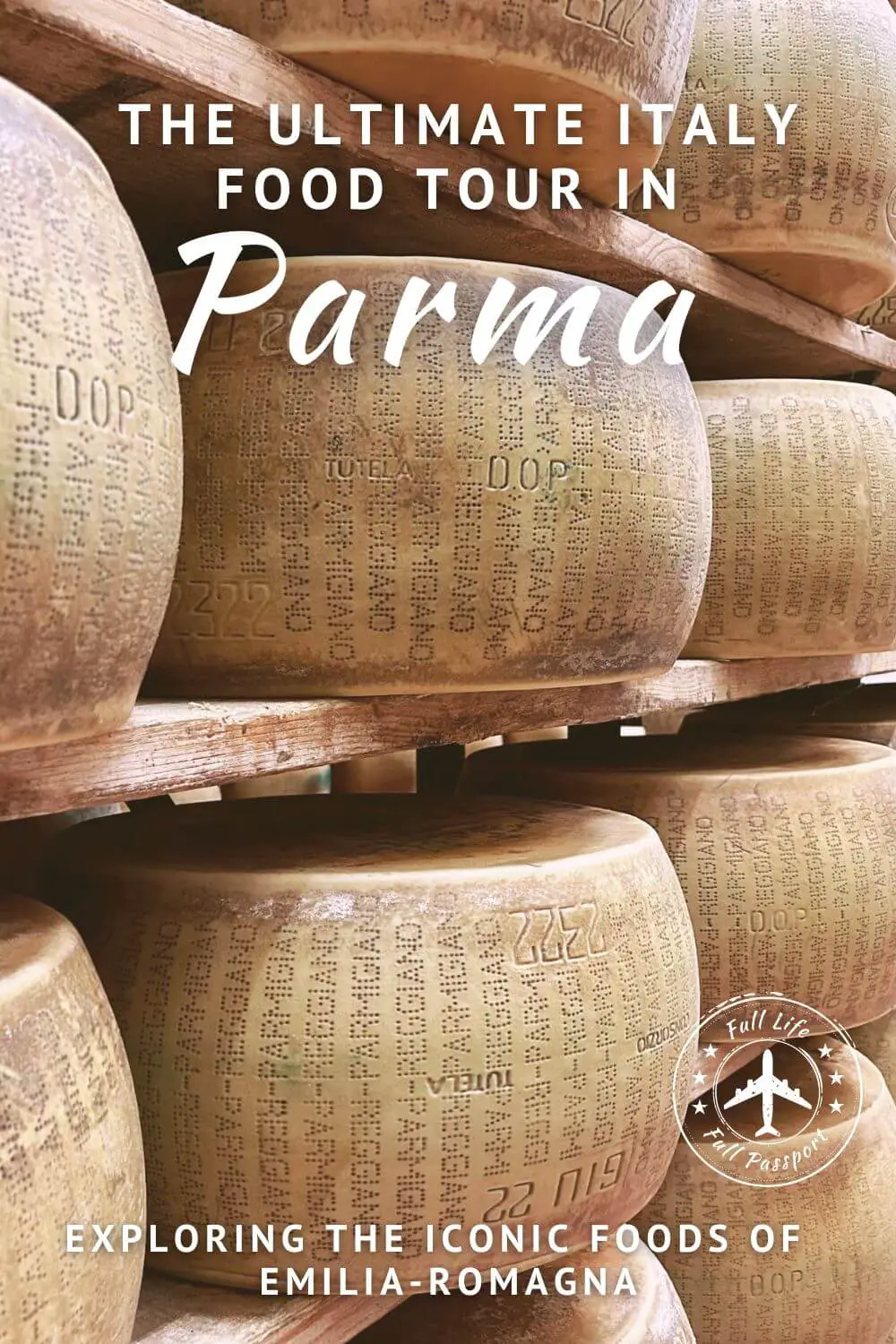
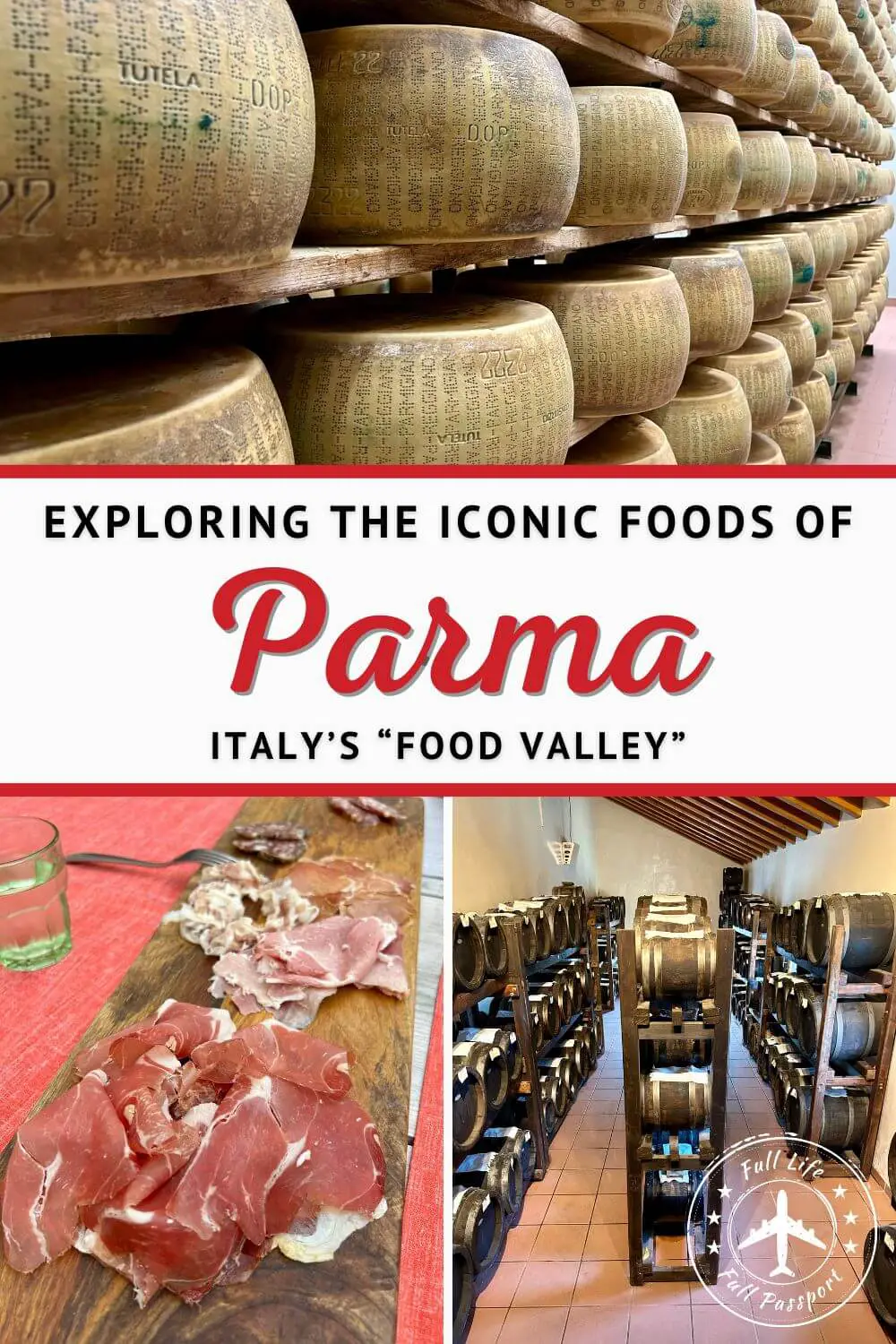

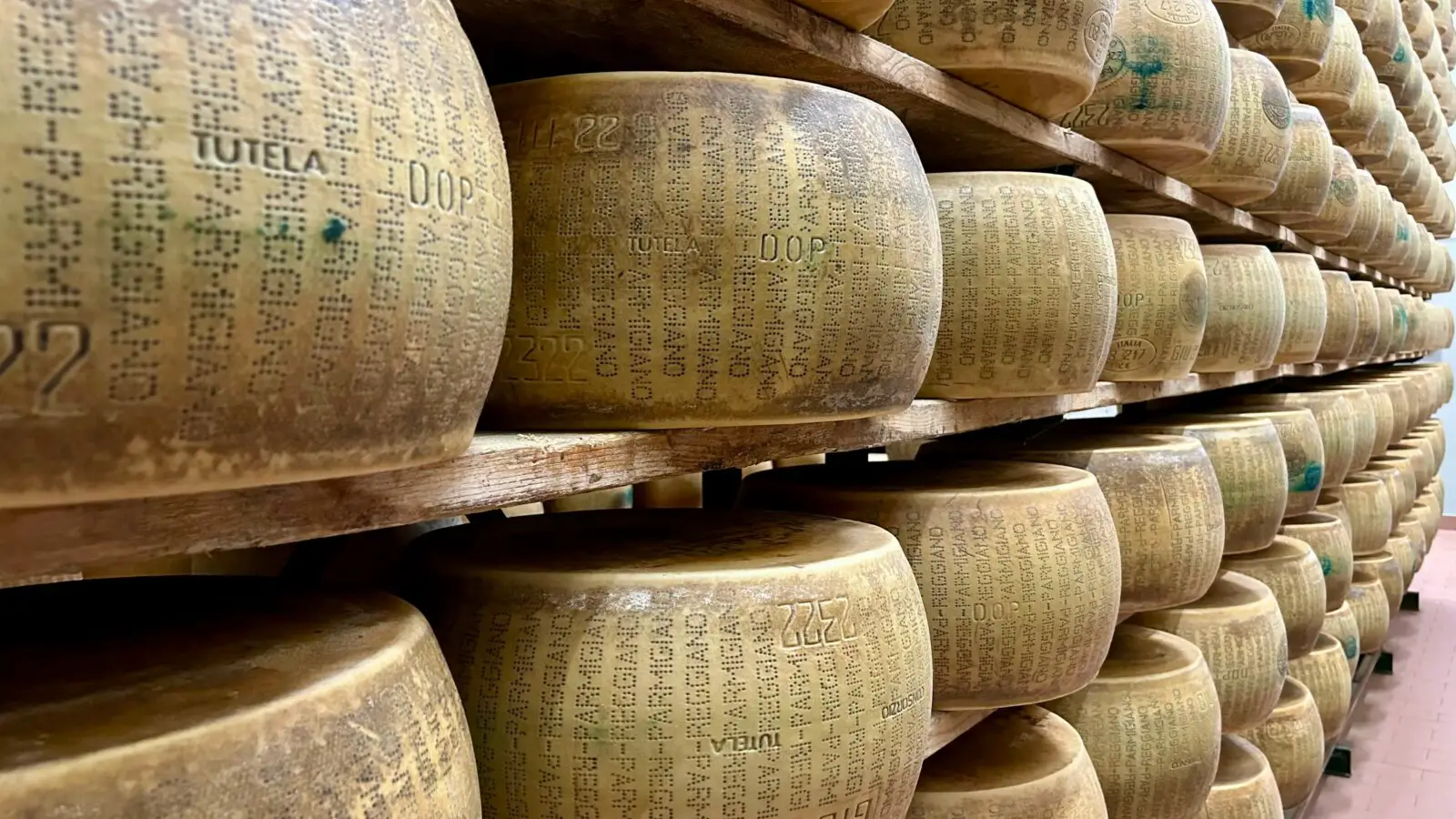
 Four Gorgeous Medieval Towns You Should Visit in Umbria, Italy
Four Gorgeous Medieval Towns You Should Visit in Umbria, Italy